




Power Quality Issues – Part 5 – Reactive Power and Power Factor 16 Rinnai delivers hot water at Scarborough Care Home 23 Keeping Commercial Heating Systems Clean 24 Energy efficiency –it’s all in the numbers 16 The importance of not losing your balance! 14 Sustainable steam generation: Powering a greener future 28 www.energymanagermagazine.co.uk OCTOBER 2023 INSIDE THIS ISSUE: BATTERY ENERGY STORAGE: The final piece of the jigsaw to support building decarbonisation See page 18
4 FREE conference theatres



Industry expert speakers


The latest product innovations

Unrivalled networking opportunities






































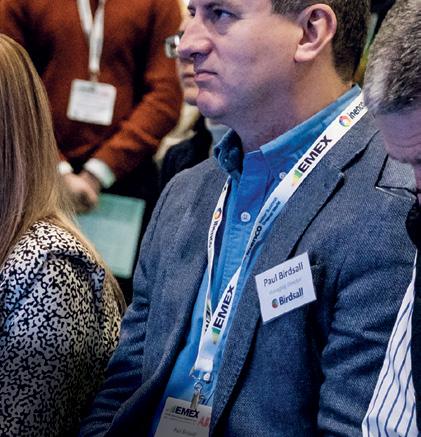










PROUD MEDIA PARTNERS











SPONSORED BY The Net Zero & Energy Management Expo 22-23 November 2023 • ExCeL London REGISTER TODAY
OCTOBER 2023
PUBLISHER: Ralph Scrivens ralph@ energymanagermagazine.co.uk
PRODUCTION: Sarah Daviner sarah@ energymanagermagazine.co.uk
ACCOUNTS: accounts@ energymanagermagazine.co.uk
PRINT: Mixam Print
ENERGY MANAGER MAGAZINE
is published 10 times a year by Energy Manager. www.energymanagermagazine.co.uk
42 Wymington Park, Rushden, Northants, NN10 9JP
Tel: 01933 316931
Email: mail@ energymanagermagazine.co.uk
REGISTRATION: Qualifying readers receive Energy Manager free of charge. The annual subscription rate is £80 in the UK, £95 for mainland Europe and £115 for the rest of the world.
Single copies £10.
Some manufacturers and suppliers have made a contribution toward the cost of reproducing some photographs in Energy Manager.
PAPER USED TO PRODUCE THIS MAGAZINE IS SOURCED FROM SUSTAINABLE FORESTS.
Please Note:
No part of this publication may be reproduced by any means without prior permission from the publishers. The publishers do not accept any responsibility for, or necessarily agree with, any views expressed in articles, letters or supplied advertisements.

All contents © Energy Manager Magazine 2023
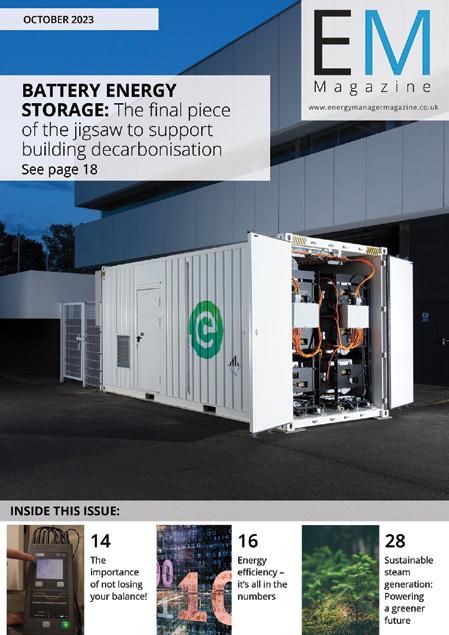
ISSN 2057-5912 (Print)
ISSN 2057-5920 (Online)
INSIDE ENERGY MANAGER MAGAZINE • OCTOBER 2023 3 4 News 12 Exhibition News 14 Monitoring & Metering 16 Energy Management 18 Energy Storage 20 Energy Supply 22 Energy Finance 25 Energy Procurement 26 District Heating 28 Steam Systems 29 Water Management 30 Lighting 32 Heating 34 Training 35 Legislation Battery energy storage: The final piece of the jigsaw to support building decarbonisation FRONT COVER STORY: See page 18
NEW REPORT REVEALS FOUR-FOLD INCREASE IN LOCAL COUNCILS PURSUING LOCAL AREA ENERGY PLANS
Sixty-six local councils (around 1 in 6) are working towards a Local Area Energy Plan (LAEPs) – recognised as the leading method for translating national Net Zero targets into local energy system action with collaborative, data-driven and cost-effective plans.
The new report Local Area Energy Planning: The Time and Place is Now provides an insight into how this innovative Net Zero approach is being utilised by local authorities to garner investment and deliver real locally led action. But the report doesn’t shy away from highlighting what more needs to be done to ensure a consistent and fair transition.
In less than two years the number of local councils working towards a Local Area Energy Plan to help shape Net Zero action has grown from less than 4% to over 16%.

Pioneered by Energy Systems Catapult, with Innovate UK support, but now being delivered by a growing market of UK suppliers – LAEPs cover electricity, heat, and gas networks; future potential for hydrogen; building fabric and systems across domestic, commercial and industrial premises; energy system generation, storage and flexibility; and integration with energy infrastructure to decarbonise transport.
The new report by Energy Systems Catapult sets out how LAEPs are already delivering clarity for local places and communities on the projects, investment and innovations needed to reach a Net Zero energy system, such as: speeding up deployment of renewables, targeting building retrofit to reduce energy bills, getting homes heat pump ready and locating EV charging infrastructure to decarbonise transport.
This report also sets the recommendations needed to ensure the quality, consistency and momentum of LAEPs is maintained, and that confidence is given to the market to support continuing development:
• Recommendation 1 – LAEP
Guidance should be adopted and endorsed nationally as the framework for place-based whole energy system decarbonisation planning. Informing other public
funding and ensuring consistency across the UK.
• Recommendation 2
– Funding all areas to undertake a full LAEP, or as a minimum, whole energy system baselining (following Stages 1-3 of the LAEP guidance). Recommendation 3 – LAEP should be embedded within the National Planning Policy Framework, and future energy network institutional and governance arrangements to consistently align spatial and energy systems planning (as shown in Wales).
• Recommendation 4 – Establishing scope for consistent data inputs across the UK to ensure all plans are comparable, interoperable and easier to refresh and update. Recommendation 5 – Centralised support for local authorities to build LAEP capability and capacity.
Guy Newey, Chief Executive at Energy Systems Catapult, said: “The UK has made incredible progress in reducing carbon emissions by almost 50% since 1990 – mainly on the back of greening the electricity system. Success in the next phase of decarbonisation – focused on buildings and transport – will to a large extent depend on whether people and local communities support the major changes in how they get their energy.
“To meet that challenge, Energy Systems Catapult, with support from Innovate UK and a number of pioneering local authorities and regional leaders, has been instrumental in developing the concept of Local Area Energy Planning over the past 8 years. It is becoming a key tool for translating national Net Zero ambition into local action. LAEPs are already helping to inform investment, secure funding and foster collaboration.
“We need to accelerate Local Area Energy Planning now, and do it consistently nationwide. The time and the place is now.”
Andrew Clark, Place Business Leader at Energy Systems Catapult, said: “Local Area Energy Planning is designed to accelerate the journey to Net Zero in line with local priorities and deliver value for money.

“For example, in Wales, Local Area Energy Plans have been commissioned for all local areas across the country, that will scale up to create a National Energy Plan by 2024. A similar commitment to Local Area Energy Planning across all of the UK’s nations could play a huge role in clarifying local priorities and galvanising action, investment and innovation at local and regional level.
“Our recommendations in this report will go a long way to ensuring that success.”
Welsh Government, Lead for Local Area Energy Planning, Huw Lewis said: “The Welsh Government has committed to Net Zero by 2050. We recognise decarbonising our energy system will be fundamental to meeting net zero and are pleased to have partnered with Energy Systems Catapult to deliver our Local Area Energy Planning (LAEP) programme. The local energy plans will improve understanding of what the energy transition is likely to involve at a local level and will also inform our national policies and programmes as we work with partners to deliver an energy system fit for the future.
Greater Manchester Combined Authority, Director of Environment, Mark Atherton said: “The Local Area Energy Plan work undertaken is powerful because it identifies not just the type of technologies that will be needed for this transition, but their scale, indicative lo-cations, and costs.”
City of York Council, Executive Member for Environment and Climate Change, Cllr Kate Ravilious, said: ”The [Local Area Energy Plan] will act as a blueprint for positive change in our city that directly benefits existing residents and businesses as well as future generations and will direct the strategy to secure the volume of inward investment we will need.”
Local Area Energy Planning is also gaining traction among policymakers in local, regional, and UK government, and is being referenced by Ofgem, by planners, and by energy net-work operators. A range of companies including Arup, Buro Happold, and City Science have begun delivering LAEPs in response to increasing demand. www.es.catapult.org.uk
ENERGY MANAGER MAGAZINE • OCTOBER 2023 NEWS 4
Four times as many local authorities are taking climate action by pursuing Local Area Energy Plans compared to two years ago, according to a new report by Energy Systems Catapult.
Battery energy storage: a versatile tool to help energy managers meet net zero goals

Battery energy storage is a tool that can transform decarbonisation for energy managers. The technological solution is capable of enhancing carbon savings, reducing emissions as well as addressing peak demand challenges caused by electrification. Download our latest free guide to learn more about how to implement battery energy storage to deliver smarter energy solutions: bit.ly/energy-manager-guide

Battery energy storage - a versatile tool for building decarbonisation A white paper for energy managers connected-energy.co.uk Connected Thought
BRIDGING SOLUTIONS ARE CRUCIAL TO MAINTAINING ENERGY RESILIENCE AMID ‘PLANNING GAP’ FOR CLIMATE TARGETS
As the Clean Air Task Force (CATF) calls for EU states to close the ‘planning gap’ to hit climate targets, Aggreko is urging high energy users across the continent to take immediate steps towards a more decentralised, renewable energy model.
The new report from the CATF has found that EU member states need to maximise the short and medium-term planning potential of their national Energy and Climate Plans (NECP). Only four of 27 member states submitted revisions to their plans ahead of the recent deadline.
With concern raised that a resilient low carbon energy infrastructure may be delayed, Aggreko is urging high energy users across Europe in sectors such as manufacturing, data centres and petrochemical refinery to adopt a decentralised energy approach on their sites.
Chris Rason, Managing Director, Aggreko Energy Services, said: “While the development of a smarter and greener power infrastructure in Europe is underway,

it is clear that delays and cost are cause for concern where energy resilience is concerned. Energy intensive industries may find adopting decentralised energy models avoid disruption caused by resilience issues relating to this ‘planning gap’ identified by CATF in its new report.
“However, upgrades through outright purchases are made more difficult because of supply chain disruption and capex costs. This means that organisations may need to plan their models more carefully using temporary bridging solutions to provide the resilience they need when moving to a renewable decentralised model.”
As businesses take steps in transitioning to a decentralised energy model, they require technologies and expertise to support their own pathways towards energy resilience and reducing emissions. To support organisations across energy intensive industries, Aggreko has highlighted solutions for high energy users to navigate a complex energy market and avoid downtime for grid resilience
DIMETA AND RINNAI TEAM UP ON GREENER GAS APPLIANCES
Dimeta, a global joint venture to accelerate the production and use of renewable and recycled carbon Dimethyl Ether (DME) has announced the signing of a Memorandum of Understanding (MoU) with Rinnai, a global manufacturer and distributor of gas appliances, to explore ways to decarbonise the LPG market in Europe through the use of DME.
Renewable and recycled carbon DME is a clean-burning, sustainable fuel made from various feedstocks, such as waste, biomass or biogas, and can reduce emissions by up to 85% compared to oil and diesel. As DME is chemically similar to Liquified Petroleum Gas (LPG) and bioLPG, it can be blended with it up to 20% and ‘dropped-in’ to existing LPG supply chains, providing a seamless pathway to reducing emissions from the over 13m tonnes used for energy in Europe each year.
Together, Dimeta and Rinnai will explore the role for DME blended with LPG and used in existing appliances, as well as 100% DME dedicated appliances, including hot water production systems, boilers and dryers. The collaboration between

Dimeta and Rinnai will initially focus on the European market and will include the two companies working together to further their knowledge and showcase the importance of collaboration across the whole value chain.

The agreement shortly follows the announcement of planning approval for Dimeta’s first-of-a-kind £150m renewable & recycled carbon DME production plant in the UK. Once operational in 2025, the plant will produce over 50,000 tonnes of DME from non-recyclable waste – the equivalent of 25% of LPG domestic heating in the UK. In addition to the first plant in the UK, subsequent plants are in development in Europe and the United States, as part of Dimeta’s goal to achieve 300,000 tonnes of DME production capacity by 2027.
Tony Gittings, Managing Director, Rinnai UK, said: “Our LPG-fuelled products play a critical role in powering off-grid communities across the world. With more steps being taken to lower global emissions, being able to provide greener solutions is key on the road to net zero. Our collaboration with Dimeta will enable us to further explore
issues in its Race to Resilience report. It identifies steps high energy users can take to safeguard power provision in the immediate future, and how other tools and services may help facility stakeholders to best guarantee long-term energy security. The report also explores how plants can reduce carbon emissions and transmission losses while boosting resilience against external events, such as insufficient power supply from the grid.
For more information and to read Race To Resilience, visit www.aggreko.com/en-gb/resources/ industry-report-race-to-resilience
the use of renewable liquid gases like DME and how we can deliver quality appliances that not only work efficiently and affordably for our customers, but contribute positively to the global environment.”
Frankie Ugboma, Chief Executive at Dimeta, commented: “Collaboration with the whole supply chain is critical to the success of the roll out of renewable & recycled carbon DME. By having the support of world-leading companies such as Rinnai, we can maximise the opportunities for DME to support the hardest-todecarbonise sectors, such as off-grid homes and businesses. Working together, we can harness our shared experience and knowledge to find bold ways to decarbonise the LPG market that will result in a greener future.” www.rinnai-uk.co.uk
ENERGY MANAGER MAGAZINE • OCTOBER 2023 NEWS 6
Image: iStock-MikeMareen
Tony Gittings, Rinnai and Frankie Ugboma, Dimeta
The partnership will explore the use of renewable & recycled carbon DME in appliances to decarbonise the LPG market.
Prefect products are designed specifically for accommodation where the room occupant is not directly responsible for paying the heating bills. Tamper-proof, robust and always striving to use less energy, our systems will improve your energy management and efficiency.


PrefectControls.com
BEYOND
Central control Local control
current control
THIS IS
YOUR CONTROL
* Savings are dependent on
methods, infrastructure, location and profiles adopted.
CENTRAL CONTROL All ecostat2 features + Secure portal access + Humidity + Light + Sound pressure + CO 2 + Water heating + Leak detection • up to 40% savings * LOCAL CONTROL • Room temperature • Setback, Boost & Frost • User adjustment • Open window • Absense detection • Tamper-proof • Programmable • Electric or wet systems • up to 30% savings * Scan for product comparison
UNIVERSITY OF NOTTINGHAM’S CREATIVE ENERGY HOMES HOST REVOLUTIONARY ENERGY STORAGE TECHNOLOGY TRIALS
The installation is the latest step for the Advanced Distributed Storage for Grid Benefit Project (ADSorB) – a consortium led by researchers from the University of Sheffield – which aims to commercialise the use of new thermal energy storage technologies developed at the University of Loughborough. The technologies store excess energy when renewable energy sources, such as solar or wind, are plentiful, so it can be released and used during peak times or to make up for shortfalls in supply.
The team previously undertook a feasibility study, where they evaluated Thermochemical Storage (TCS), which can offer longer term storage, and Phase Change Material (PCM) technologies, which are more agile and offer shorter term storage. Combined, the two have the potential to significantly reduce carbon emissions, provide a more flexible approach to renewable energy storage and support
the country’s net zero ambitions. These technologies have since been developed and adapted to become modular thermal energy stores that can be slotted into homes alongside the household’s existing energy system – whether that’s as part of a retrofit or within a new build. These prototypes have been installed at Nottingham.

Mark Gillott, Professor of Sustainable Design at the University of Nottingham, said: “Soaring household bills have been hitting headlines for months as the cost-of-living crisis continues. Therefore, finding an effective alternative has never been more important. Thermal energy storage has the potential to solve two issues in one – not only is it cost effective, but it also removes renewable energy’s dependency on specific weather conditions.
“This is the first of two installations scheduled to take place at Nottingham this year. We’ve started with PCM technology and will follow with TCS later on in autumn, which will provide us with comparable data for both types of technology. By undertaking these trials at lived-in homes, we’ll be able to provide accurate results that will allow us to scale up the technology and bring it to market as quickly as possible.”
Alongside Nottingham, the project team is made up of researchers from Sheffield and Loughborough, universities, as well as Mixergy – the

market leader in innovative, gridconnected hot water storage.
Dr Rob Barthorpe, from the University of Sheffield’s Department of Mechanical Engineering, said: “This is an exciting milestone to have reached and we are now looking forward to generating the data, and creating an evidence base to demonstrate the benefit that distributed energy storage can provide. We hope this will validate our modelling that showed not only consumer benefits through reduced bills, but grid and carbon reduction benefits that will make significant contributions to the UK’s net zero goals.”
One of the two houses where the trials are taking place is currently occupied by Komal Siwach and her family. She said: “We’ve been living in our Creative Energy Home since 2019, and we’re really excited to be part of the first phase of installations as heat pumps are more efficient than more conventional boilers and furnaces. I’m expecting this will lower our energy bills by between 30% and 40%.”
The £2.6m project is funded by the Department for Business, Energy and Industrial Strategy (BEIS) through the Longer Duration Energy Storage Demonstration programme, part of the £1bn Net Zero Innovation Portfolio (NZIP). For more information about the ADSorB Project, please visit: https://adsorb.ac.uk/
ENERGY MANAGER MAGAZINE • OCTOBER 2023 NEWS 8
New energy storage technology, which could significantly reduce household bills and help the UK achieve net zero, has been installed at the University of Nottingham’s Creative Energy Homes.
FOCUS ON DELIVERING VALUE TODAY
FOR A SUCCESSFUL AND SUSTAINABLE TOMORROW
To engineer a more efficient, safer and sustainable world you need the right steam and thermal energy partner. Whatever your key drivers, Spirax Sarco have you covered.


Find out more at spiraxsarco.com/advance
Sustainability Efficiency Safety Energy Management
PAGABO’S £1.6BN DECARBONISATION FRAMEWORKS OPEN FOR BIDS
The offering brings two brand-new frameworks to the market, which are both valued at £1.6bn and will run for four years once live. Each will have its own contracting authority, with one framework dedicated to healthcare schemes having Great Ormond Street Hospital (GOSH) serving as a sector-specialist host. Meanwhile, the second framework will be open to clients from all other sectors, hosted by Kingston upon Hull City Council.
The framework will appoint contractors to provide a complete business solution for clients. This will allow clients to go directly to main contractors to undertake the retrofit assessments, work up costs, and bring in supply chain partners to deliver the scheme, while serving as a single point of contact.
Following market engagement, Pagabo has made some revisions to the setup of the frameworks. Both will now have four value banded lots, applicable to the 12 geographical regions.
• Lot 1 – up to £1m
• Lot 2 - £1m to £5m
Lot 3 - £5m to £15m
Lot 4 - £15m+
The frameworks are also split by three scopes to ensure that main contractors are active in the relevant market, with a requirement to submit case study evidence. The scope will include but not be limited to cover:
Domestic Low Rise
• Domestic High Rise
• Non-Domestic – commercial, health, education, and leisure

Jason Stapley, chief procurement officer at Pagabo, said: “With the
ongoing climate crisis, accessing specialist organisations and critical skills for retrofit and decarbonisation works has never been more important for clients – but it’s critical that these services are procured with full compliance, which is why we’re very pleased to be bringing this framework offering to the market.
“Our aim is always to make things as simple and efficient as possible for both clients and suppliers, which is why certain changes have been made to the decarbonisation framework during development after the Prior Information Notice (PIN) earlier in the summer.

“When developing this offering, it had initially included a lot for retrofit consultancy services. However, our continued engagement with the market has revealed these services are best placed within our Professional Services offering for market clarity. With both frameworks intended to go live at a very similar time, there will be the ability to link through from the retrofit consultancy lots under the Professional Services framework to the decarbonisation framework, thereby providing a clear procurement route for any works clients require.
“As always, our commitment to fairness across the market sees a number of allocations reserved for
SMEs across the 12 geographical locations, making sure that clients are able to access the talent and skills lying across the whole market.
“We intend these frameworks to provide the vehicle to help clients with their net zero projects and strategies, with the dedicated offering meaning that all-important decarbonisation schemes can be procured and underway as quickly as possible – for the benefit of people, communities and the planet.”
Interested parties are encouraged to submit their bids before 23 October 2023. Those wishing to be appointed to both the healthcarespecific and wider sector offerings will be required to submit two separate tenders, which will be evaluated according to each framework.
To submit a bid for the Framework for Decarbonisation Solutions dedicated to healthcare schemes, visit https://in-tendhost.co.uk/ pagabo/aspx/ProjectManage/1271
To submit a bid for the Framework for Decarbonisation Solutions available to all other sectors, visit https://in-tendhost.co.uk/pagabo/ aspx/ProjectManage/1270
For more information, please visit https://www.pagabo.co.uk/
ENERGY MANAGER MAGAZINE • OCTOBER 2023 NEWS 10
Jason Stapley, chief procurement officer at Pagabo
Suppliers are now able to bid for Pagabo’s newest framework offerings, specialising in decarbonisation projects.
Ground Source Heat Pump Association expresses Concern over the phase-out of fossil fuel boilers


Ken Gordon, CEO of the Ground Source Heat Pump Association (GSHPA) wishes to express deep concern on behalf of our members regarding the delay to the phasing-out of fossil fuel boilers. This decision poses significant challenges to the UK’s 2050 climate targets and the growing but fragile heat pump industry.

1. More To Do, Less Time: Postponing the phase-out effectively shortens the window to retrofit and replace millions of heating systems. A delay now will only compress the timeline later, making the challenge exponentially
greater. Rapid transformation will be required closer to 2050, putting undue strain on industry resources, supply chains, and skilled labour. Achieving the 2050 targets becomes riskier and potentially more expensive for both homeowners and the government. This does not safeguard ordinary families; it means they will have to expect even more disruption in the future. Government should provide the funding required for transition, not families.
about climate change.
3. Impact on Housing Developers: The recent decision will undoubtedly lead housing developers to reconsider or cancel existing contracts for eco-friendly heating solutions, in favour of traditional fossil fuel boilers. Not only does this put existing contracts and investments at risk, but it also contradicts the broader vision of a sustainable, lowcarbon future for the UK’s housing sector.
Source: https://www.carbonbrief.org/unep-1-5cclimate-target-slipping-out-of-reach
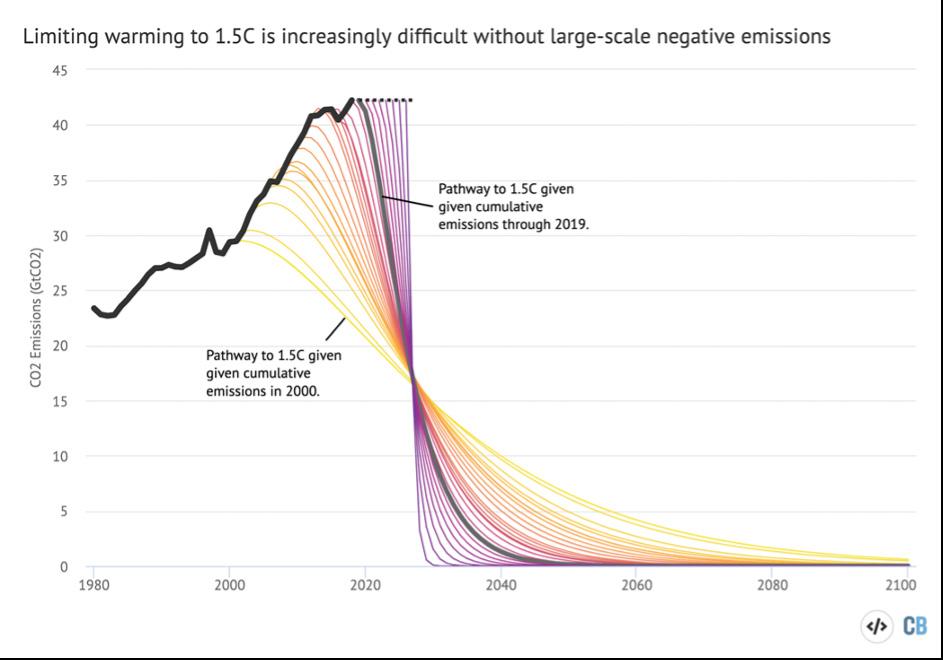
2. Setbacks to the Heat Pump Industry: The ground source heat pump sector, along with other heat pump industries, has been steadily growing in response to previous government guidelines and commitments. The industry has heavily invested in research, development, and workforce training to meet anticipated demands. A delay in policy would destabilise this growth, causing uncertainty and potentially lead to job losses, and reinforce consumers’ reluctance to join an industry that is volatile to such sudden policy changes. This affects many families who are now even more confused about the way to do something
4. Damaging Signal to Stakeholders:

A delay would signal a grave lack of commitment to addressing the most urgent crisis facing the world today and would break faith with all concerned stakeholders including younger voters. We, at the GSHPA, understand the complexities involved in such policy decisions. However, it is crucial to acknowledge that short-term leniencies might lead to longterm consequences that could be costly. We urge the government to reassess the implications of the delay. The GSHPA remains committed to assisting the government in achieving its 2050 climate goals and ensuring a sustainable future for all. https://gshp.org.uk/

ENERGY MANAGER MAGAZINE • OCTOBER 2023 NEWS 11
THE ESOS ETHOS
For large companies, there is a six-month reprieve for filing the next (Phase 3) Energy Savings Opportunity Scheme (ESOS) report. Although a clear deadline is in place, 5 June 2024, other details remain unclear as the underpinning legislation isn’t expected to make its way through Parliament until at least this month.
The scheme covers energy use of UK companies employing more than 250 people with an annual turnover of greater than £44m and an annual balance sheet total greater than £38m. Companies that don’t carry out an energy audit or file a report can be fined by the Environment Agency, as well as named and shamed.
Introducing the idea behind the scheme is George Richards, director of environmental consultancy JRP Solutions, which is a qualified ESOS lead assessor. “Previously, energy was never given priority or focus in boardrooms. A lot of energy was being wasted across UK PLC. When ESOS came in, the idea – particularly with the director having to sign off the report – was that it would be seen as an opportunity; they would be encouraged to invest in some of the opportunities and make them happen.” While in the early days this was seen as a tick-box exercise, attitudes are now changing in the face of the energy crisis and drive to net zero, he reports.
Compared to the previous Phase 2 filing process, some of the changes required for Phase 3 are minor; all data must be verifiable and evidenced, the
organisational structure has to be clear and include company numbers and SIC codes, as well as an energy metric such as intensity (kWh/unit of production or per m2 of office space, for example). Companies also have to report on any energy conservation measures (ECMs) have been carried out since Phase 2, although there is officially no obligation to actually implement them.
Energy usage needs to be split between building, process and transport (including so called ‘grey fleet’ – employees’ own vehicles). And although 100% of energy must be accounted for, only 95% has to be audited; that’s up from 90% before. Data submitted needs to be 12 months’ continuous energy that includes the so-called ‘qualification date’ of 31 December 2022.
One of the largest open questions actually relates to a post-Phase 3 requirement. Between 6 June and 31 December 2024, companies must file an action plan, the nature of which remains unclear, and will require further clarification from government, Richards says. And it’s still possible that the requirements might change, he adds, putting the company’s assessment work in regulatory limbo, and increasing costs.
In JRP’s case, all of these contracts include the audit as well as the assessment. Lead assessors carrying out the mandated review of the ESOS report are required to be approved by a trade body (see also www.is.gd/vayiba).
Richards adds: “With a site visit, the point is to get an understanding of how energy is managed, or not; to identify and look at the culture around energy. Is it important? Is it a focus? Do they have good data collection?

What is the quality of the data, and metering systems? Do they have good MMT: measurement and management technologies. Do they have team meetings, and an awareness of energy?”
And JRP at least follows up to help its clients implement ECMs. He concludes: “We can investigate alternative methods for delivery...and help improve reporting, metering, data and behaviour change. That last one is a big opportunity that is often ignored or undervalued.”
With an extensive two-day programme of free-to-attend learning across four conference theatres, including a session from JRP Solutions, EMEX 2023 is the place to discover more about this and other current hot topics within the energy management space. The show is also delighted to welcome a wealth of exhibitors to the event, including JRP Solutions, showcasing the latest technological advancements across the sector. Visit the website to find out more: www.emexlondon.com.
Register your FREE place today and join the largest gathering of energy managers and sustainability professionals in the UK. EMEX 2023, London ExCeL, 22-23 November 2023.
https://emex-2023.reg.buzz/em

12 ENERGY MANAGER MAGAZINE • OCTOBER 2023 EXHIBITION NEWS
PEL 103 Power & Energy Logger


Bridge the energy gap between today and tomorrow. Increase energy e iciency and reduce your costs.



Measure and monitor power usage. Identify ine iciencies and out of hours use. Discover power factor, phase balance and harmonic issues.




CHAUVIN ARNOUX UK Ltd | 125 YEARS IN BUSINESS | 30 YEARS IN THE UK 1 Flagship Square | Shaw Cross Business Park | Dewsbury WF12 7TH | T: 01924 460494 | E: info@chauvin-arnoux.co.uk
us to learn more
Contact
energy
are
and businesses
to
their energy
iciency. You can reduce
generation,
money and increase productivity. Gain a competitive advantage now with the PEL 103.
The key to a reduced carbon footprint & improved energy e iciency. Our future
needs
changing
need
improve
e
required power
save
THE IMPORTANCE OF NOT LOSING YOUR BALANCE!
When a commercial or industrial electrical system is first designed and installed, amongst many other things, great care and consideration is given to the distribution of any single-phase loads across the three phases to ensure they are evenly balanced.
describes a variation in a power system in which the voltage magnitudes, or the phase angle differences between them, or both, are not equal.

Voltage imbalances are caused by big single-phase loads, such as induction furnaces, traction systems, and other large inductive machines, either drawing a current between one phase and neutral
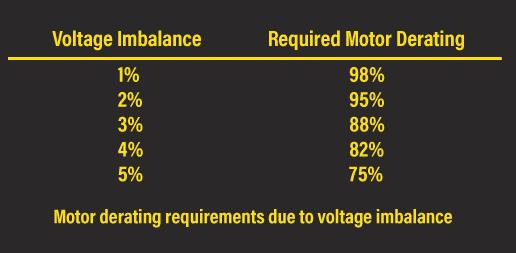
At the least, uneven loading will result in one or more phases carrying a higher current than the others, which increases losses due to heating and reduces the available supply capacity. But at its worst, it could lead to a voltage imbalance that negatively affects some of the 3-phase equipment in the same installation.
A three-phase power system is said to be balanced when the phase voltages have the same amplitude and are separated by a phase angle of 120 degrees. Accordingly, voltage imbalance
that does not appear on the other two phases, or between two phases such that current is only drawn on two out of the three. Either way this causes the higher loaded phases to experience a greater voltage drop, reducing the voltage on those phases for all the other equipment connected to the same supply.


Such loads previously only really existed in large industrial installations, however the deployment of Level 2 EV chargers throughout light industrial and commercial / educational facilities is expanding the issue significantly. Level 2 single-phase chargers can draw over 7kW, and so careful consideration should be given to the numbers deployed and the phase distribution of them, while also considering the existing phase loadings.

The uneven distribution of lower power, more general, single-phase loads across a 3-phase system can also sometimes be bad enough to cause a slight voltage imbalance. This often occurs as an installation, originally balanced during its design and construction, has additional circuits and equipment added to it over time.
In rarer cases, voltage imbalance can be caused by the unequal degradation or failure of one or more PFC capacitor units in a bank, and
14 MONITORING & METERING ENERGY MANAGER MAGAZINE • OCTOBER 2023
The load or phase balance of a threephase installation is often unknown or ignored despite being of vital importance to ensure optimum performance and efficiency of the installation and the equipment within it. In this article, Chauvin Arnoux UK’s Julian Grant discusses the implications of poor load balance within an electrical installation, why it could be of critical importance, and how to avoid it.
temporary voltage imbalances can be produced by a fault on any one of the phases either within the facility or further back up the supply network.


Having balanced phase voltages is arguably one of the most important requirements for an industrial installation, particularly if it contains 3 phase motors. Unbalanced voltages at motor terminals can cause a phase current imbalance of up to 10 times the percentage voltage imbalance for a fully loaded motor. Accordingly, motors operating on imbalanced supplies need to be de-rated with significant reductions in available loading for relatively minor voltage imbalances. Imbalances can also require the necessary de-rating of power cables due to increased I2R losses in the cable.
According to the IEC, voltage unbalance is defined as the ratio of negative sequence voltage to the positive sequence voltage. Basically, the three phase voltages can be mathematically expressed as a sum of positive, negative and zero sequence components. Positive sequence voltage creates flux in the direction that the motor is intended to rotate, and negative sequence voltages rotate in the opposite direction. This creates flux in the opposite direction, however, since the positive sequence voltages are always much larger the direction of motor rotation is not affected.
The counter rotating negative sequence flux caused by negative sequence voltages creates additional heating in the motor windings that will eventually lead to insulation breakdown and premature
motor failure. A continuous operation at 10 °C above the normal recommended operating temperature can reduce rotating machine life by a factor of two.
IEC 60034-1 imposes a 1% negative phase sequence voltage limit on the supply feeding machines. However, EN 50160 states that imbalances of up to 3% can be expected.
Apart from the motors themselves, many solid-state motor controllers and inverters include components that are especially sensitive to voltage imbalances. Some will protect themselves and the motor in the event of voltage imbalance and refuse to operate. For less sophisticated devices reduced life of Variable Frequency Drive (VFD) front end diodes and bus capacitors are a common result of voltage imbalance.
UPS, polyphase converters, and inverter supplies also perform with reduced efficiency in the face of voltage
imbalances on the supply, creating unwanted ripple on their DC side and, in many cases, also creating increased harmonic currents on the supply.
Fortunately, the measurement of voltage and load (current) balance, and therefore the identification of imbalance, is easily achieved using a power and energy logger (PEL). Connected at the incoming supply the loading across the phases for the whole installation can be monitored over time to see how it might vary during the normal operating day or week.
PELs can be quickly moved around the installation, nonintrusively connected, and utilised to measure individual equipment or circuit loads and voltages to achieve balance throughout the installation, and then reconnected to the incoming supply for ongoing monitoring. As well as voltage and load balance this will enable measurement and monitoring of other power quality parameters including power factor and harmonics.
There are two obvious precautions or actions to reduce voltage imbalance and its effects. Firstly, use separate circuits for large single-phase loads and connect them as close to the point of the incoming supply as possible. This will ensure that the load does not cause a voltage drop on any wiring utilised by other equipment that would then be subjected to that voltage drop. Secondly, ensure that all single-phase loads, large and small, are balanced evenly across all three phases. Two simple steps that could save a lot of headaches and expense.
https://www.chauvin-arnoux.co.uk/

15 ENERGY MANAGER MAGAZINE • OCTOBER 2023 MONITORING & METERING
PEL103 showing unbalanced phase loading
PEL103 showing voltage imbalance across phases
ENERGY EFFICIENCY –IT’S ALL IN THE NUMBERS
For those unfamiliar with Irus, it is the Building Energy Management System designed specifically for multi-occupancy dwellings, ensuring energy can’t be used unnecessarily.
It maintains comfortable environments by heating spaces to a pre-determined Setback temperature but, gives occupants a Boost range should they require more heat. As soon as pre-set times elapse, a room is vacated, or windows and doors are opened, heat input is reduced.
Tom has been with the company since March 2021 and quickly learnt the ropes with all things Irus. He has managed installations at more than 40 sites in all corners of the UK from Aberdeen to Exeter.
He comments, “It’s been a steep learning curve, but on the whole installation goes very smoothly. Our company ethos is ‘Cleverly simple control of energy’, and that applies to the design of our products, how they combine as a system, installation, and the user experience.” He continues, “We use Mains Borne Signalling (MBS) for communication between room controls and the brains of the system. Using the mains as a mesh-network for the site speeds up installation and negates the need for the cost and disruption of installing additional cabling. Our team can complete 250-300 rooms per week.”
THE NUMBERS JUST KEEP GROWING
There are now 50,000 control units at 101 sites. These include university campuses, PBSA student accommodation providers, and hotels. Currently the largest single site is UWE with over 3,000
controls. Additional blocks are going online over the next few months. The site in Bristol saw a saving close to 900,000kWh1 in the year following the initial installation. Along with UWE, Prefect clients include universities in Bangor, Bath, Bradford, Bristol, Cambridge, Durham, Greenwich, Lancaster, Oxford, Surrey and York. While PBSA operators include Unite Students, Study Inn, Curlew Capital, Every Student, Host, UPP, Student Roost and Collegiate.
REMOTE MONITORING AND MANAGEMENT

But it’s not only the size, and the number of installations that are growing. The scope of what Irus is capable of controlling is also rapidly increasing. First there was heating control for individual rooms. Then environmental conditions - humidity, light, sound pressure (db) and CO2 monitoring.
The control units report data back to designated personnel via the internet portal, raising alerts when unusual conditions are detected, such as high humidity, excessive noise or temperatures that are greater than the pre-sets.
BROADENING THE SCOPE
The number of interconnecting devices that seamlessly integrate to monitor and control has also expanded, boosting the power of the Irus Portal.

Earlier this year, SMART Tank was introduced - the only pre-plumbed, pre-wired hot-water cylinder with onboard controls. It enables complete monitoring and management of water temperatures and volumes. It detects and reports leaks around the water system and, in the event of water escape, will activate Auto Shut-Off valves, helping
1 On pre-install consumption
to minimise flood damage by preventing additional water from entering the system. Being pre-plumbed and wired means installation is quick and efficient.
PipeSense uses Bluetooth to communicate with the Irus system, taking the legwork out of water temperature data-logging. It measures water temperature within pipes at point of use. This information can be used as evidence to prove water safety plan criteria is being met. It also monitors room AND pipe temperature, identifying water wastage through dripping taps or leaking toilet cisterns.
HobSensus is helping to keep residents safe in kitchens. It ensures electric hobs cannot be left switched on if the person preparing food is distracted and leaves the hob unattended. This reduces the risk of cooking appliance fires, which is the top cause, accounting for almost half (46%), of all accidental house fires in the UK2. HobSensus is a standalone device, however, when integrated with Irus, greater functionality can be unlocked.
ENERGY SAVINGS, DE-CARBONISATION AND NET-ZERO TARGETS
Tom concludes, “Being part of the drive to de-carbonisation, and helping accommodation providers on their journey to reach Net-zero targets, is a fulfilling part of the job. With Irus and our local controls, we calculate that around 10% of the UKs student accommodation estate is now controlled by a Prefect product3.” www.Prefectcontrols.com
2 Information from Morgan Clark Loss Assessors
3 Based on approx.200,000 controllers (Irus and Ecostat/Local controls) / 1.7Million student rooms
16 ENERGY MANAGEMENT ENERGY MANAGER MAGAZINE • OCTOBER 2023
Tom McAndrew, Project Manager at Prefect Controls, witnessed an auspicious event recently. The installation of the 50,000th control unit on the Irus Portal!
THE FIVE QUESTIONS ENERGY BROKERS MUST ANSWER
Hidden commissions cause anxiety for UK businesses – and rightly so. Many companies have unknowingly paid extortionate amounts to untrustworthy brokers in the form of undeclared commissions.
It’s time to eradicate ambiguous communications on the state of the market. Nearly half (42%) of UK businesses are unclear on how much they’re charged by their broker, and it’s the duty of brokers to provide transparency on commissions and the services they provide for fees, to help businesses gain clarity on available energy plans.
For organisations to best handle a volatile market, meet regulatory changes, and avoid secret fees, they should ask their energy broker the following questions.
How many suppliers do you currently work with, and do you have special rates with any?

Businesses should be positioned to quickly assess their energy broker’s network and be aware of the range of energy procurement strategies on offer.
Brokers should provide a list of energy suppliers they work with and the percentage of business they place with each supplier. If a broker isn’t willing to provide a comprehensive list of their suppliers, they aren’t being transparent.
A good spread is across seven or eight reputable suppliers – they shouldn’t be tied to one key supplier, and having relationships with multiple suppliers indicates a good reputation.
Do I pay you directly, or do you get a commission from suppliers, and what exactly is included in that fee?
The next question is on how brokers are paid for their services to help gain a clear understanding of all costs involved and reduces the chance of businesses paying hidden fees. Recent stats show that 37% of businesses believe their broker is providing a free service.
Trustworthy brokers will disclose how they are paid in writing, confirming the commission they are earning from the supply contract and that there are no additional fees paid to them from the supplier.
Delvin Lane, Managing Director, Energy Management at eEnergy Group Plc

There’s no industry norm in broker fees, which is part of the problem. Brokers have been known to include commissions of up to 5p per kWh, whereas a good broker will cap fees below 1p per kWh.
If a fee of 5p per kWh is included, for example, the commission on a 200,000kWh contract would be £10,000 per year. A reputable broker, with a cap of 1p per kWh, would charge a fee of £6,000 across a three-year contract.
What type of energy procurement strategy, fixed, basket, or flexible, do you recommend for the business?
This is about tailoring. The best brokers will grasp an organisation’s consumption habits, risk tolerance, and sustainability goals. They’ll know that while fixed contracts offer budget stability, they aren’t always the best fit. Basket contracts can be a way for businesses to amplify their buying power. Flexible contracts? They offer the chance to exploit market changes for savings – but beware of brokers promising low costs that evaporate once the contract kicks in.
How do you ensure my business gets the best price?
Businesses should know how brokers not only source the best energy rates, but how they negotiate with suppliers to ensure their clients receive the best offers.
The standard broker model is to call 5 suppliers and then present the best price to the client. With an advanced auction platform, some can engage with as many as 25 suppliers for gas and power, setting them against each other to secure the best deal.
Often, the final bid comes in around 9% lower than the starting price. Not all brokers are created equal when maximising savings.
Can you provide me with references that I can talk to?
Businesses should validate both their broker’s credibility and quality of service by speaking to their clients.
It’s recommended that businesses ask for three client references, either in the same industry or with a similar consumption profile. Written case studies aren’t enough – businesses should also ask for the name, title, and contact details of clients for an independent conversation with them.

IN CONCLUSION
With energy markets evolving rapidly, UK businesses deserve a transparent, honest relationship with their brokers. By asking the right questions and demanding clear answers, companies can ensure they’re not only getting the best deal but also partnering with a broker that truly has their best interests at heart. Don’t stay in the dark. It’s time to illuminate the industry standards. https://www.eenergy.com/
17 ENERGY MANAGER MAGAZINE • OCTOBER 2023 ENERGY MANAGEMENT To receive Energy Manager Magazine FREE of charge, please visit: energymanagermagazine.co.uk/ subscribe www.energymanagermagazine.co.uk
BATTERY ENERGY STORAGE:

THE FINAL PIECE OF THE JIGSAW TO SUPPORT BUILDING DECARBONISATION
Energy managers have already achieved significant reductions in energy consumption. The next phases of decarbonisation are much more challenging – but help is at hand.
Energy managers have already made great strides towards decarbonisation, but the hard yards lie ahead. However, help is at hand in the form of a new guide from energy storage experts, Connected Energy.
‘Battery energy storage – a versatile tool for building decarbonisation’ is a white paper for energy managers. It explores the role of battery energy storage in driving the decarbonisation of buildings, with a focus on supporting energy managers to adopt and implement this new technology.
“Energy managers have to think creatively if they are to deliver on the next phases of decarbonisation,” says Matthew Lumsden, CEO and founder of
Connected Energy. “Battery energy storage systems can be a very versatile tool in helping them unlock carbon savings in a variety of ways.”
QUICK WINS
Naturally, most organisations have targeted the low-hanging fruit, which meant energy efficiency measures such as LED lighting, HVAC optimisation and more efficient plant and equipment. This is often supported with employee behavioural change to create a corporate culture of energy efficiency. The next stage is typically introducing smart building technologies to better control and automate systems that
consume a lot of energy. This includes sensors, smart lighting and building management systems that can optimise energy based on demand.
INTO THE HARD YARDS
The next steps are harder, but Connected Energy’s guide explains three ways a battery energy storage system (BESS) can help:
1. Load management – Helpful if you are implementing plans to reduce peak energy demand. This might mean staggered use of equipment during peak hours or shifting nonessential business activities to offpeak times. A BESS supports this
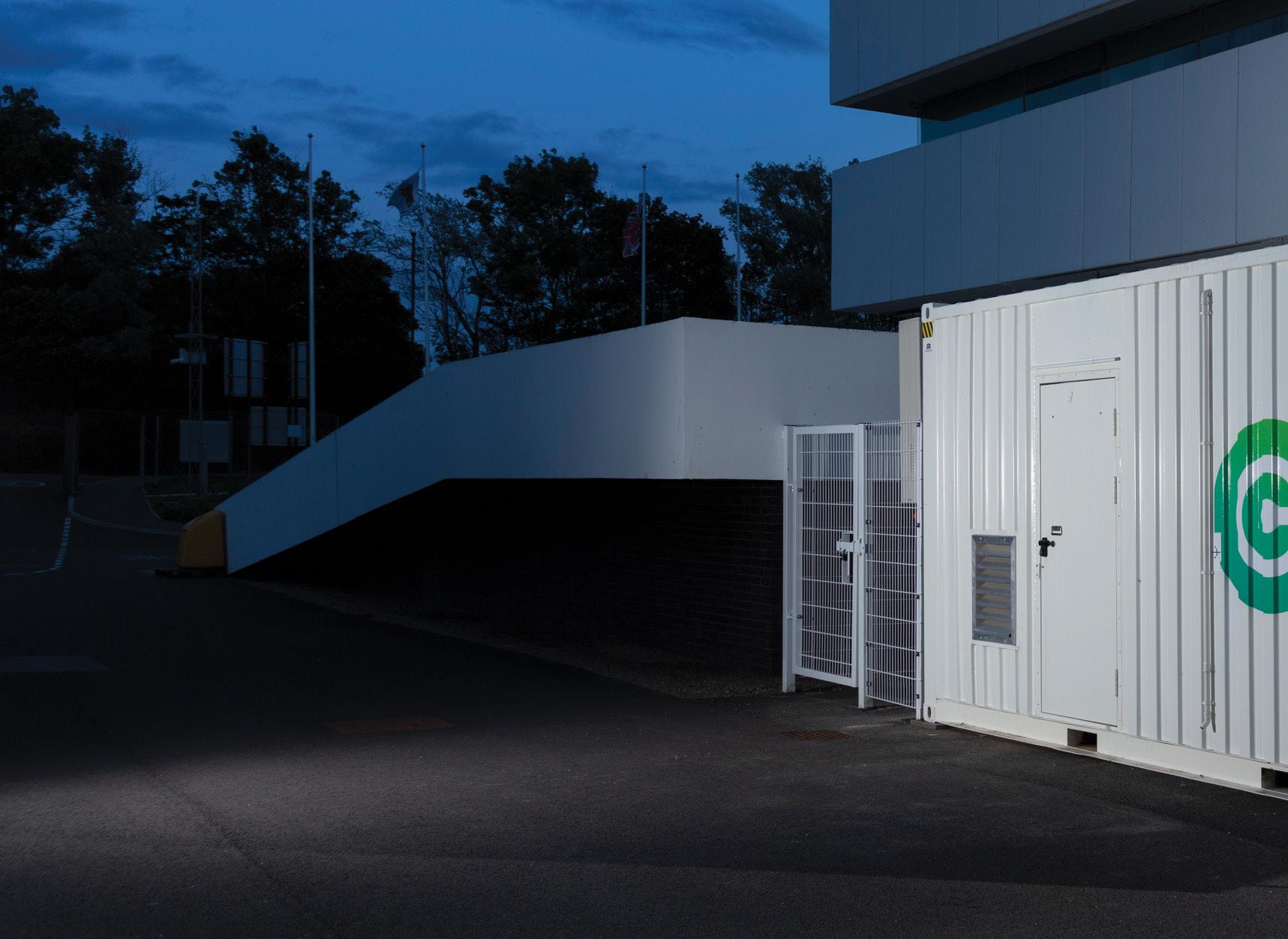
18 ENERGY MANAGER MAGAZINE • OCTOBER 2023 ENERGY STORAGE
through programming to respond to loads on site. By providing power during periods of peak demand it reduces reliance on the grid.
2. Renewable energy – a BESS can store surplus energy generated by solar, for use as and when required. This helps optimise the use of renewable energy, reducing the carbon intensity of your energy consumption.
3. Electrification – a major pillar of most decarbonisation strategies is the electrification of heat and vehicles. However, both areas require a significant amount of power. A BESS can be vital here as it helps overcome grid capacity constraints, manage peak loads and help your fleet make the most of on-site renewable energy.
KEY BENEFITS
A cornerstone of building decarbonisation, battery energy storage can play a pivotal role in enhancing energy efficiency and minimising environmental impact. It can also contribute to reductions in Scope 1 and 2 emissions. The guide highlights four ways in which a BESS can support building decarbonisation:
ENERGY STORAGE

1. Storing greener grid energy from the grid during periods of high renewable generation. This reduces the carbon intensity of the energy you buy from the grid, lowering your carbon emissions.
2. Capturing excess renewable energy from on-site generation. The intermittent nature of solar and wind can be offset by storing energy during peak generation periods and releasing it during times of low generation.
3. Overcoming grid capacity issues when installing energyintensive equipment.
4. Supporting load management strategies during periods of peak demand, helping to reduce stress on the grid.
SIGNIFICANT SAVINGS
Based on real-world data from existing operational systems, Connected Energy calculates that a single 300kW E-STOR system can save you 100 MWh of electricity, which is the equivalent of 18 tonnes of carbon emissions each year.
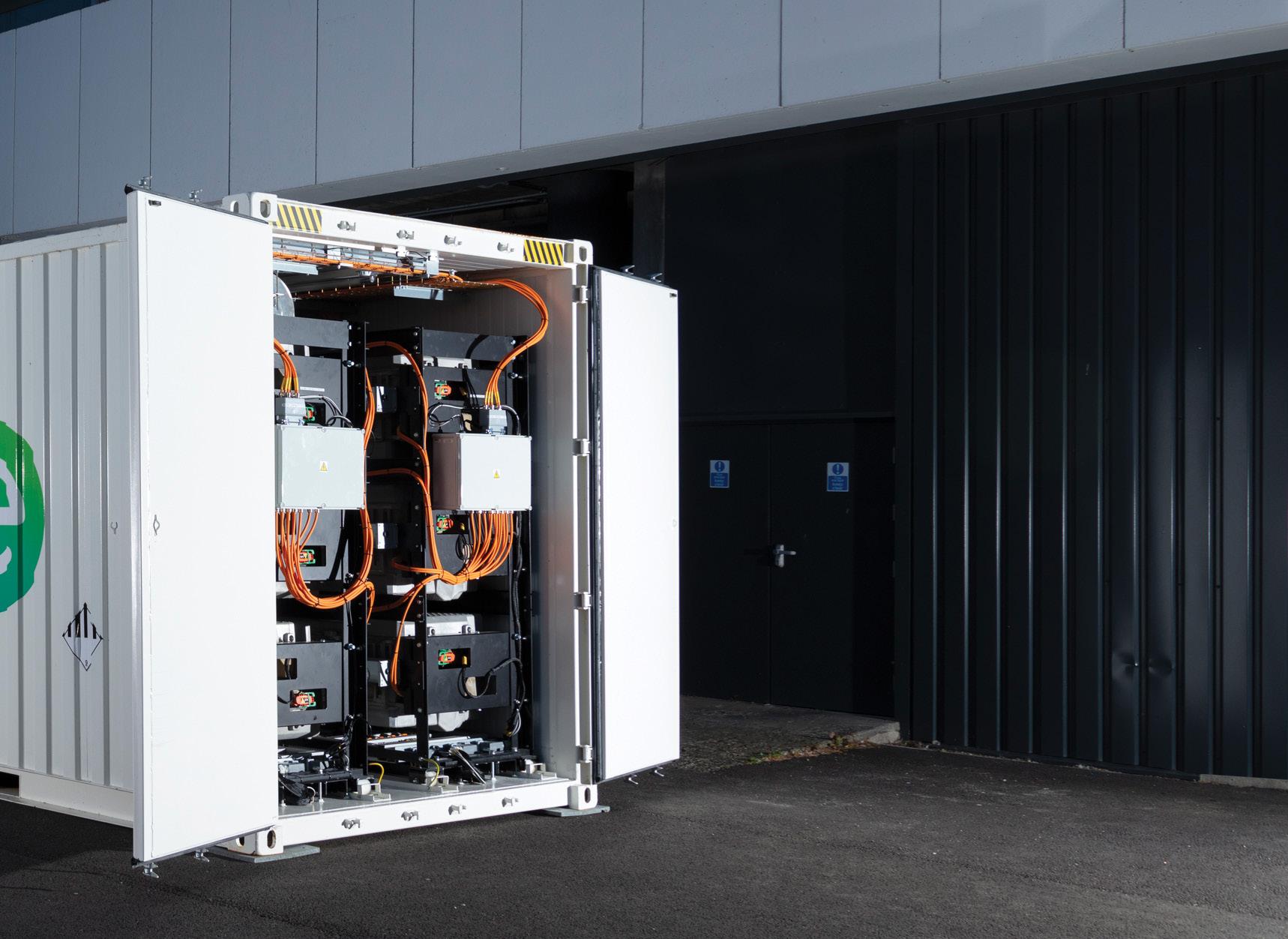
In addition, a huge benefit to businesses looking to decarbonise is that Connected Energy uses second life batteries for its E-STOR product. This not only contributes to a company’s
Scope 3 emissions, but it can also help meet funder requirements for suppliers to actively reduce their own emissions. Market analysts McKinsey estimate that, in 2025, there will be 800m tonnes of EV batteries ending their first life applications. And this figure will only continue to grow. Finding a solution to reusing these electric vehicle batteries is critical to reduce waste by contributing to the circular economy. Each E-STOR system by Connected Energy provides a positive carbon benefit of 150 tonnes of CO2e compared with a BESS using brand new batteries.
“Energy storage of any kind can deliver carbon savings for buildings,” says Matthew. “However, production of new batteries for BESS comes at an environmental cost. This is where Connected Energy comes in. We have developed a unique solution capable of reusing EV batteries in BESS; creating a system which is better for the environment and goes further to help organisations meet their net zero goals.
FIND OUT MORE
Battery energy storage is a dynamic and innovative technology which can revolutionise the way buildings can manage and consume energy. To find out more, download the free white paper here: bit.ly/energy-manager-guide
19 ENERGY MANAGER MAGAZINE • OCTOBER 2023
THIRD PARTY ENERGY COSTS ARE FORECAST TO CHANGE IN 2024 – HOW WILL THIS AFFECT YOUR BUSINESS?
After a volatile year in 2022, wholesale energy prices have been much more stable in 2023. A mild winter saw strength in storage stocks, helping to suppress prices throughout the year.
Now, in its latest Third Party Costs (TPCs) Guide, Drax Energy Solutions forecasts that overall energy costs will be lower in 2024 due to wholesale energy reductions, providing a muchneeded boost for businesses.
Paul Miller, Director at Drax Energy Solutions, explains what you need to know.
Commodity markets
At the start of this year, we saw energy prices on a more reasonable trajectory, which has continued as a monthly decrease ever since. Wholesale energy prices in September are approximately 47% lower than they were in January this year.
The decline in wholesale prices can be credited to a mixture of things. This includes robust gas storage reserves, enhanced supply accessibility and favourable weather patterns.
Looking ahead to next year, pricing dynamics will remain focused on supply and demand factors. A mild winter in 2022 resulted in strong (gas?) storage stocks, helping to suppress the prices throughout 2023 to date. However, there’s still a degree of risk with post-winter wholesale energy contracts as the market vigilantly monitors supply and demand fluctuations that may arise due to potentially colder weather conditions this year.
Third party costs (TPCs)
Over the past few years, a substantial increase in wholesale prices has meant that the TPCs portion of a typical energy bill has decreased from 60% to around 40%. However, the underlying charges for TPCs are still very high compared to the historical data. This means even the smallest change can have a significant impact on your energy costs. Many third party costs are now forecast to decrease in 2024, while others are predicted to rise. Below is a breakdown of the individual costs that make up this figure and any trends we expect to see in 2024.
Balancing Services Use of System (BSUoS)
In April this year, the National Grid Electricity System Operator (NGESO) shared the fixed tariff for summer 2024 (April to September) and draft tariff for winter 2024 (October to March). We now know that the projected costs for BSUoS will substantially decrease for the upcoming year compared to the current tariffs. The reduction in forecasted costs for the 2024/25 period is predominantly due to falling wholesale electricity prices topped up by overrecoveries in total costs during 2023. In addition, there’s an over-recovery in 2023/24 winter contingency costs.
Contracts for Difference (CfD)

The CfD Levy has experienced significant fluctuations, which is not unexpected given recent wholesale price volatility. Due to a drop in the wholesale price, the average CfD forecast has increased by £2.60/MWh from 2023/24 onwards compared to Drax’s previous TPCs Guide. Drax’s experts forecast a fall in CfD costs for 2024/25. However, the CfD scheme predominantly depends on day-ahead wholesale prices as most of the generation is from wind. Therefore, forecasting is challenging, especially given the recent volatility in wholesale prices.
FEED-IN TARIFF (FIT)
As of April 2023, Guarantees of Origin are no longer accepted under the rules of the FiT and CfD schemes. Therefore, no additional volumes are
exempted after the Energy Intensive Industries (EIIs). FiT is forecast to increase in 2024/25 by 8.7% (middle case).
Energy Intensive Industry (EII) changes

In February 2023, the government announced strategic measures to help Britain’s EII become more competitive in the European market. These include increasing the EII Renewable Levy Exemption, a potential new exemption from Capacity Market costs, and a proposed EII Network Charging Compensation Scheme (offering compensation for grid-related charges).
Distribution Use of System (DUoS), Transmission Network Use of System (TNUoS), and Renewables Obligation (RO)

There have been no changes to these third-party costs since the Spring TPCs Guide, and forecasts remain the same.
Paul Miller, Director at Drax Energy Solutions, shares: “The past 18 months in the energy market have been a testament to its resilience and adaptability. With the unprecedented market conditions, including high wholesale prices and notable volatility, we’ve witnessed Government and Regulatory intervention.
Since our last Third Party Costs (TPCs) Guide in April, we’ve seen the emergence of the Energy Bills Discount Scheme, and now, we eagerly await Ofgem’s forthcoming review of the nondomestic supply market this autumn. Notably, the industry is experiencing an accelerating pace of modifications and significant code reviews, all outlined in the new Autumn Third Party Costs Guide.
Looking ahead to 2024/25, we forecast a range of third party costs will decrease, with fluctuations and new, potential changes, while other TPCs will increase. Drax remains dedicated to providing reliable, sustainable, and forward-thinking energy solutions, and we’re working closely with our customers to understand these changes and minimise their costs going into 2024.”
To find more about third party costs, energy market news, analysis from the past few months, plus forecasts, download the Drax Autumn TPCs Guide here –https://energy.drax.com/insights/ third-party-costs-autumn-2023/
20 ENERGY SUPPLY ENERGY MANAGER MAGAZINE • OCTOBER 2023
MOTIVATING ENERGY MINDFULNESS IN HEAT NETWORKS
If you haven’t yet come across motivational tariffs when talking about utility billing, that soon may change. Already proven successful in Europe, this innovative approach to improving the performance of heat networks reached the UK earlier this year, and plans are in place for a wider roll-out.
In a nutshell, motivational tariffs provide financial incentives to residents to encourage energy saving behaviours. They empower customers to take control of their energy use, helping to align the interests of heat suppliers and residents to lower bills and carbon emissions.
ROOM FOR IMPROVEMENT
When heat networks perform optimally, they can be cheaper and use less carbon than homes heated by individual gas boilers. Yet many in the UK operate at only 35-45% efficiency.
A key performance indicator is the difference between system flow and return temperatures, known as Delta T (ΔT). A high ΔT means end users will be getting the same amount of heat at a lower cost, as there will be less heat loss, a more efficient energy centre and reduced emissions. A good supply temperature should be around 60°C with a return temperature of 30°C, but it’s more usual to see supply temperatures of 80°C with a 75°C return temperature, causing a low ΔT and low network efficiency. Inefficient heat networks ultimately need larger pumps and pipework to meet the unnecessarily high flow and energy demand and in turn, because equipment has to work harder, have a much shorter replacement cycle, driving up capital costs and power consumption.
If you want to improve your ΔT, everyone connected to the network has a part to play. ‘Weak links’ in the system will result in higher costs for everyone. But it can be hard to get people to understand and engage with the opaque technicalities of network optimisation, particularly when the size of their energy bill depends as much on what their neighbours do as on their own behaviour. This is something quite alien to the UK.
CLEAR ADVANTAGES
This is where motivational tariffs come in. They solve this dilemma by translating collective benefits into tangible cost savings for individual households. And they really do work. In Denmark, where around 64% of all homes are on heat networks, motivational tariffs have succeeded in reducing return
Anthony Coates-Smith, Managing Director, Insite Energy
temperatures by an impressive 10°C over 10 years. In one notable case, an operator in Viborg realised over €679,000 of efficiency gains across its portfolio by motivating residents to upgrade their heating systems.
At Insite Energy, we’ve seen first-hand the impact of motivational tariffs in our own pilot programme conducted last February at a 300-unit residential site in London. The trial focused on servicing access and showed highly promising results. Previously, when the managing agents tried to arrange service visits, 59.3% of households didn’t reply. When those residents who engaged and scheduled an appointment were offered a more favourable tariff rate, this number dropped to 8.3%, most of which were sublet properties.
UK FIRST
Following this test case, Insite Energy is now looking at rolling out motivational tariffs at a measured pace across its client base. As the first heat network metering & billing provider in the UK to implement this approach, we’re cognisant of the need to get it right. It will require something of a culture change in a sector that itself remains unfamiliar to most people. That means information and education will be needed.

Phase One of the rollout will see us gathering data about average return temperatures as well as introducing this concept to users, using a simple traffic-light system, via our digital webapp, KURVE (another UK first).
In Phase Two, we’ll introduce hypothetical monetary values to actual
and desired return temperatures, with target return temperatures tailored to individual sites. New-build sites will have lower targets for efficiency, as one would expect them to be working well already. For older sites with ageing equipment, targets will reflect realistically achievable gains.
A review of data from 1,091 Insiteoperated meters from Jan-Jul 2023 showed that over 81% of households would save money straight away under a motivational tariff scheme as their system is already performing efficiently, based on a good average return temperature (using volume weighted average return temperatures (VWARTs) being less than 45°C. The 6.8% of accounts in the inefficient ‘red’ zone (an average return temperature over 55°C), who would be on a more punitive rate, would be able to take prompt action to improve their tariff.
As with any new initiative, there will likely be some challenges to overcome. Cooperation and communication between heat suppliers and residents will be crucial. We will proactively provide clear information about how the tariffs would work and offer support and guidance to householders who need help to lower their return temperatures.
Heat networks have the potential to be the preferred low-carbon choice for communal buildings, but only if they’re optimised to work efficiently. Motivational tariffs could be a powerful tool to improve their performance.
https://insite-energy.co.uk/

21 ENERGY MANAGER MAGAZINE • OCTOBER 2023 ENERGY SUPPLY
£13.7 MILLION AWARDED IN THE FIRST HEAT NETWORK EFFICIENCY SCHEME FUNDING ROUND
Gemserv is delighted to announce that £13.7 million has been awarded to local authorities, housing associations and private sector applicants in the first Heat Network Efficiency Scheme (HNES) funding round.
As a testament to the Government’s commitment to heat network infrastructure across Britain, Gemserv can today confirm that £13.7 million of capital and revenue grant funding has been awarded to improve the efficiency of existing district and communal heat networks. This equates to 43% of the total budget allocated to the scheme and will seek to improve heat networks serving over 11,000 residents, demonstrating its popularity and the demand for support.
Heat networks present a vital technology that can deliver efficient, lower cost heating, cooling and hot water to the UK’s built environment at scale. HNES aims to improve heat network performance in existing/operational projects where customers and/or operators are experiencing sub-optimal outcomes. With a focus on reducing customer detriment, HNES supports heat network consumers impacted by the costof-living crisis by enhancing efficiency and combating poorly performing networks.
The announcement shows the positive engagement from heat network owners and operators across the country as they seek to embrace the technology, ensure customers are getting the best value for money and that networks are operating efficiently. The first three funding rounds have proven incredibly popular, and we anticipate that future rounds will be very competitive.

Lord Callanan, Minister for Energy Efficiency and Green Finance, welcomed the announcement:
“Families and businesses shouldn’t have to worry about whether they will receive a reliable heating and hot water supply. This funding means improvements will be made to old and inefficient heat networks, preventing further breakdowns, and ensuring they use less energy.
We’re investing millions to build new heat networks, reducing emissions, and
providing low-cost heating to communities across the country. But it’s equally important we upgrade and maintain existing systems so everyone benefits.
Heat networks offer carbon emissions savings by supplying heat to buildings from a central source, avoiding the need for households and workplaces to rely on individual, energyintensive heating solutions - such as gas boilers. As such, heat networks provide a significant contribution to the UK’s carbon reduction commitment.
But some heat networks haven’t been upgraded since they were installed more than 40 years ago, meaning many are inefficient due to not being installed properly, poorly maintained or the equipment wearing out.
The Heat Network Efficiency Scheme (HNES), which opened in February this year, forms an important part of the government’s support for heat networks. This also includes the £288m Green Heat Network Fund, which supports the creation of heat network projects that use a low carbon heating source, such as a heat pump, solar or geothermal energy, to provide heat and hot water to connected homes and businesses.”
Commenting on first funding announcement from the HNES scheme, Louise Singleton, Principal Consultant at Gemserv said:
“Today’s announcement shows the substantial impact that HNES will have on the efficiency of heat networks across the country. Funding from the scheme today will play a huge part in improving the efficiency and lowering the costs of domestic heating for thousands of residents and businesses.
Nearly £14 million awarded will ensure existing heat network infrastructure is fit for the future, ensuring the technology can provide the most efficient, economical heating for consumers, and preparing them for greater expansion to new and existing homes.”
CAPITAL GRANT FUNDING
Capital grant funding will go directly towards covering the cost of operational works to improve the efficiency of existing heat networks. In this round, nearly £13 million will directly improve the efficiencies of heat networks serving over 4,000 residents.
HOUSING ASSOCIATIONS AND SOCIAL HOUSING PROVIDERS
• Notting Hill Genesis, one of the largest housing associations in London and the South East, has been awarded over £3.6 million for improving the efficiency of heat networks that serve over 800 residents. Building on optimisation studies funded through the HNES Demonstrator, the Glyn Street, Windmill Park, St Pancras Way and Factory Quarter Estate projects will use their capital funding to replace HIUs and pipework, install more efficient control systems and insulation, and for other general efficiency improvements.
• Southern Housing, one of the largest housing providers in the UK with more than 78,000 homes across London, the South East, the Isle of Wight and the Midlands has been awarded over £176,000 to improve a heat network serving homes on Dagenham Heathway & Church Elm Lane Dagenham, Essex. Additional insulation, new HIUs and other improvements will be installed using funding from HNES which will create a more efficient heat network and as a result a reduction in resident bills and the buildings carbon footprint.
• Great Places Housing Association, with 25,000 homes across the North West, South Yorkshire and Derbyshire, has been awarded over £1.6 million to improve the efficiency of its Richmond Park heat network, serving 299 residents across the development. Drawing on the recommendations from their HNES Demonstrator funded optimisation study, capital funding will seek to remedy high heat loss issues, bad insulation and old equipment.
• The Guinness Partnership, with
22 ENERGY FINANCE ENERGY MANAGER MAGAZINE • OCTOBER 2023
over 140,000 customers across the country, has been awarded £2 million for the improvement of four heat networks serving almost 700 residents. Taking learnings from HNES Demonstrator funded optimisation studies at Whitfield Street and Loughborough Park, these heat networks alongside Bearbrook Place and Edgeley will utilise funding to reduce heat network costs and heat losses, improve insulation and replace outdated infrastructure.
LOCAL AUTHORITIES
• Leeds City Council has been awarded over £2.2 million to improve the efficiency of heat networks serving 837 residents across the borough. Using the recommendations from their HNES Demonstrator funded optimisation studies, Cottingley Heights & Towers, Ebor Gardens and Saxton Gardens will use HNES capital funding from the first round to improve their heat networks’ efficiency through improving insulation levels, reducing heat losses and leakages and for additional improvements.
• The London Borough of Hackney will receive over £114,000 to improve the efficiency of two heat networks serving 64 residents at their Daniell House and Heathcote Point developments. Currently, the networks are operating at extremely low efficiencies and funding will seek to improve this through the installation of heat interface units, radiator valves and other improvements that were identified in their HNES Demonstrator funded optimisation studies.
• Stockport Metropolitan Borough Council has been awarded over £1.8 million to improve the efficiency of the York Street Heat Network which currently serves 227 residents. As recommended in their HNES Demonstrator funded optimisation study, the pipework will be replaced, along with other pieces of outdated infrastructure and the heating systems within the resident’s properties will be updated.
PRIVATE SECTOR DEVELOPMENTS
• Switch2, delivering heat network solutions across public, private and third sector developers, has been awarded over £822,000 to improve a heat network serving 319 residents across the City
House development. Funding has been provided to address high heat losses, low efficiency levels and service interruptions through implementing a new control and maintenance strategy as well as insulating large parts of the network.
• Metropolitan, a leading heat network owner and operator, has been awarded £300,000 to improve the Hallsville Quarters heat network which currently serves 528 residents with a further 630 homes being connected during 2023. The funding will seek to reduce heat losses and high return temperatures through insulation, control improvements and other upgrades.
• Barings Core Fund Keel Operating Limited has been awarded over £307,000 to improve The Keel development serving 240 residents. The funding was awarded to help reduce the heat network’s heat losses and high return temperatures as well as general unreliability. This will be done through general improvements and infrastructure updates, as recommended in their HNES Demonstrator funded optimisation study.
• Avignon Property Management Limited has been awarded over £23,000 to improve the Guildhall Apartments low temperature hot water system. Funding will address inadequate heat supply to residents and flow imbalances.
• REVENUE GRANT FUNDING
Projects across the country have also been awarded over £640,000 worth of funding for optimisation studies to review the performance of their heat networks, identifying areas of improvement to ensure high performance and maximum efficiency. This funding will contribute to improving the efficiency levels of heat networks serving over 7,000 residents. The following heat networks have been awarded revenue grant funding for optimisation studies:
HOUSING ASSOCIATIONS AND SOCIAL HOUSING PROVIDERS
• Clarion Housing Group, for the Tredegar and Falconers Court heat networks, serving 134 residents.
• Flagship Group, for the Munhaven Close heat network, serving 22 residents.

• Great Places Housing Association, for an optimisation study of the
Hutton Lodge heat network, serving 29 residents.
• Home Group Limited, for the Huntley Place heat network, serving 129 residents.
• Islington & Shoreditch Housing Association, for the West Central Apartments and Mildmay Avenue heat networks, serving 173 residents.
• Notting Hill Genesis, for the Stoke Quay Estate and Reservoir & Watersreach heat networks, serving 479 residents.
• Octavia Housing, for the Bridgewater House, Park Lodge and Jane Lidderdale House heat networks, serving 85 residents.
• One Housing Group, for the Velocity and Suttons Wharf heat networks, serving 310 residents.
• One Manchester, for the Erneley Close heat network, serving 32 residents.
• The Guinness Partnership, for the John Hannam House, Apna Ghar and Stead Street heat networks, serving 198 residents
• The Riverside Group, for the Rydal Gardens and Weetslade Court heat networks, serving 75 residents.
• whg Housing Association, for the Humphries House, Austin House and St Annes heat networks, serving 393 residents.
• Wolverhampton Homes Ltd, for the Hickman Estate heat network, serving 228 residents.
LOCAL AUTHORITIES
• Leicester City Council, for the Leicester District Energy Scheme, serving almost 3,000 residents.
• Manchester City Council, for the Plymouth Grove heat network, serving 509 residents.
PRIVATE SECTOR DEVELOPMENTS
• 21-39 (Odd) Addenbrooke’s Road Freehold Limited, for the Williams Building heat network, serving 10 residents.
• Kingsway Court, for the Kingsway Court Heat Network, serving 109 flats on Brighton & Hove seafront. The funding will improve antiquated heating and hot water systems, cut costs, reduce environmental impact, and boost service to residents.
• Switch2, for the Budenberg, Altrincham and Park Hill heat networks, serving 509 residents.
• St George West London Limited, for the Fulham Reach heat network, serving 677 residents. HNES@gemserv.com
23 ENERGY MANAGER MAGAZINE • OCTOBER 2023 ENERGY FINANCE
THE FUTURE LOOKS SMART FOR TECHNOLOGIES THAT SAVE AND CREATE ENERGY
Whilst popular visions of the future are dominated by depictions of space exploration, Black Mirror gadgetry and AI droids, energy saving technologies rarely get much recognition from Hollywood directors or sci-fi fanatics. Operating quietly in the background, however, smart buildings offer a glimpse of a future that is greener, cheaper and more comfortable… and even better, it’s a future that is happening now.
Smart buildings are already an important link in the Net Zero chain, not least because they bridge the gap between the long-term interests of the planet, and the immediate needs of people’s lives.
Operating through an ecosystem of sensors, meters and controls, smart buildings run more efficiently, with lower energy demands cutting bills as well as emissions. This quiet revolution started many years ago, with simple technologies like motion-sensing lights and the steady adoption of thermostats, but it has advanced to the point that buildings are increasingly self-monitoring and refining.
In practice, subtle changes to the operations and systems in a building can have snowballing effects, both positive and negative. Just as undesirable habits like leaving lights on or windows open can dramatically increase wastage, automated lighting and zonal heating systems can massively improve a building’s efficiency, and that’s good news for energy managers and inhabitants alike. Across the public sector, as in many residential properties, reduction in unnecessary consumption is not simply an environmental priority, but an economic necessity. In the context of a cost-ofliving crisis and volatile energy markets, we simply do not have energy to waste.
When the government set up the Public Sector Decarbonisation Scheme in October 2020, the goal was clear: to reduce emissions from public sector buildings by 75% by 2037 if compared to a 2017 baseline. But whilst the focus of this programme is on delivering widespread improvements to heating systems, up to 58% of a Public Sector Decarbonisation Scheme grant can be spent on energy efficiency measures,

illustrating the importance attached to future-proofing buildings as part of the scheme. With 40% of the UK’s emissions linked to the built environment, it is clear that such technologies will form an important part of the overarching Net Zero campaign.
At Salix Finance, where the Public Sector Decarbonisation Scheme is managed and delivered, it is our opinion that the best designed projects are those that invest in what we call the ‘whole building’ approach, whereby energy efficiency measures like insulation, double glazing and Building Energy Management Systems (BEMS) reduce the energy demand of the building before any new heating system is sized. With less peak load required of the new heating system, both capital costs and bills can be significantly reduced.
Let’s take the example of a school, for instance. Basic fabric upgrades like insulation, draught proofing and double glazing will reduce the heat that is lost unnecessarily through the fabric of the building, and that means less heat is needed to keep students warm through those cold winter months. If the heating system in place uses fossil fuel, then these measures save carbon directly, but even if the heating system in place is a heat pump, these measures still reduce the school’s emissions by reducing the electricity demand on the grid.
Taking the example another step further, what happens if we introduce a Building Management System to regulate the building’s energy consumption?

After all, a Tuesday night sports club doesn’t require the maths block to be heated, just as a Wednesday night maths session doesn’t require toasty changing rooms for the swimming pool. Programmable energy systems can allow us to dictate which parts of a building are heated and when, just as motion sensing lights can cut down on the utility costs of brightly lit empty rooms.
The positive effects of such measures are not just financial, however. Whilst the importance of insulation during the winter has been an emotive political subject over the last few years, recordbreaking high temperatures mean there is a creeping need for our buildings to be cooled in summer. Insulation
measures can help with this too, reducing the heat flow to ensure that less of the heat outside gets in, and less cool air from air conditioning gets out. But smart technologies can take another step forward, allowing the likes of sun shades, blinds and reversible heat pumps to make buildings safe havens from rising temperatures outside.
With ever greater incorporation of technologies that can both save and create energy, buildings are not just becoming more sustainable, but more comfortable, more responsive, and cheaper for their inhabitants. That is a vision of the future that we can all get behind.
Andrew Kemp is an Energy and Programme Manager at Salix Finance. Salix Finance is a Non-Departmental Public Body (NDPB). We help drive the transition to a low-carbon future by delivering and administering grant and loan funding on behalf of the Department for Energy Security and Net Zero, the Department for Education (DfE) and the Scottish and Welsh Governments. The schemes we manage finance energy efficiency and heat decarbonisation projects within public sector buildings in England, enabling the public sector to reduce carbon emissions in line with the UK Government’s commitment to become net zero by 2050. www.salixfinance.co.uk
24 ENERGY FINANCE ENERGY MANAGER MAGAZINE • OCTOBER 2023
FIXED OR FLEXIBLE: WHICH POWER PURCHASE AGREEMENT IS THE RIGHT ROUTE TO MARKET FOR YOUR POWER?
Energy is a hot topic at the moment, particularly in terms of how the UK can accelerate the move to a safe, sustainable and secure energy system. As such, the Department for Energy Security and Net Zero (DESNZ) recently announced a raft of consultations and measures designed to put the UK on the right path to energy independence and a zero carbon future.
At the same time, businesses have been grappling with increased energy costs while also looking at cost-effective ways to ramp up their sustainability plans. The public sector is no different – from education to healthcare, organisations have had to navigate higher energy prices during a time when finances are already tight, while also demonstrating their commitment to the UK’s net zero ambitions.
As a result, many are considering new ways to reduce their energy consumption while also lowering emissions. One option that is becoming popular is installing sustainable on-site energy generation as a way of mitigating energy risk and hitting sustainability targets.
Another benefit of investing in an on-site asset is that it could also generate additional revenue, through selling excess power to eager corporate buyers via a Power Purchase Agreement (PPA).
HOW TO SELL YOUR POWER TO BUSINESSES
PPAs are contracts that agree energy production output and its subsequent purchase. They are made between asset holders who generate renewable power and commercial buyers. In short, they are a valuable route to market for generators to sell their power.
As an established method of managing energy sales and risk in generation projects, PPAs encompass all the commercial terms required to deliver a route to market for generation. They include start date, delivery schedules, pricing mechanisms, and payment terms and can include renewable certificates such as Renewable Obligation Certificates (ROCs) and Renewable
Vish Sharma, Head of Power Purchase Agreements at npower Business Solutions

Energy Guarantees of Origin (REGOs). They are usually valid for several years and offer pre-set or to-be-determined prices for energy purchases.
A PPA can cover an existing generation asset or provide assurance and confidence to investors in the financing of new renewable projects. PPAs can therefore be agreed upon before a project becomes fully functional.
TO FIX OR FLEX?
PPAs typically offer either fixed or variable pricing arrangements.
A FIXED PRICE PPA:
• Sets an upfront, guaranteed price for each unit of power you export Provides a straightforward income stream, protected from volatile energy market fluctuations Offers competitive prices with the reassurance of regular, reliable payments
• Has agreed prices for typically between 6-36 months
• Is typically suited to smaller asset portfolio holders looking to cover their own overheads and sell the excess power.
A FLEXIBLE PPA:
• Gives you control – you determine when and how much power you sell over the course of the contract
• Tracks the wholesale energy market to capitalise on price peaks and high demand

• Allows generators to benefit from real-time guidance via our awardwinning Optimisation Desk and secure Risk Navigator portal Is ideal for generators with sporadic output and larger or growing asset holders
• Has the option of sophisticated flexible agreements for more advanced sellers
When it comes to selling your power, deciding which PPA is best
can be complex and is based on a range of factors, including:
• Annual output: fixed PPAs can be a good choice for generators with a limited annual output. However, if your annual output is 6 GWh or more, flexible PPAs could offer a better route to market
• The nature of your generation: some renewables, such as biomass power, offer a steadier output regardless of weather conditions. Others, like wind and solar PV, are more intermittent and weather-dependent
• Your time constraints and risk appetite: the energy market is complex, and your familiarity with it can be a deciding factor when choosing the best PPA for your asset
• Your organisation’s objectives: whether you want a steady and risk-free revenue stream or wish to optimise profits with a flexible agreement, your goals will ultimately determine which PPA is best for you.
MAKING THE MOST OF YOUR ENERGY ASSET
Embedding independent energy generation – including those installed on-site on commercial and public sector premises – into the UK’s wider energy infrastructure ultimately improves the reliability of our renewable energy supply and supports the growth of homegrown clean energy. These generators can also help organisations procure their power from renewable sources, particularly when availability from the national grid is in increasingly short supply.
For more support on the best routes to power for your asset, npower Business Solutions’ latest guide for energy generators can be downloaded here: https://npowerbusinesssolutions. com/resources/how-to-make-themost-of-an-energy-generation-asset
25 ENERGY MANAGER MAGAZINE • OCTOBER 2023
ENERGY PROCUREMENT
EXPLORING THE ROLE OF MATERIAL SPECIFICATION IN HEAT NETWORK DESIGN

As the UK makes strides to achieve net zero, district heating is rapidly emerging as a key technology in enabling this transition. Its advantages are increasingly being recognised, and it is an affordable, lowcarbon distribution method for heating and hot water for both urban and rural settings. This is best demonstrated by stats from the Association for Decentralised Energy, indicating that there are 17,000 heat networks in the UK, supplying half a million customers1 This marks a substantial increase over earlier figures from 2013, when there were only 2,000 heat networks in the UK, with 211,000 users2
However, despite these successes, heat networks only contribute around 2-3% of the UK’s total heat demand at present, which is much lower than that of many European contemporaries. This is not to say that efforts are not
1 https://energysavingtrust.org.uk/what-districtheating/
2 www.theade.co.uk/assets/docs/resources/ Heat%20Networks%20in%20the%20UK_ v5%20web%20single%20pages.pdf
being put in place to bring the UK’s heat network numbers in line with that of the continent, with the Government pushing this technology via a variety of initiatives and incentives.
Namely, the £288 million Green Heat Network Fund (GHNF) was introduced in March 2022 to support the development of new heat networks, alongside the retrofitting and expansion of older systems, with a view to accelerating the growth of the district heating market in the UK. In turn, this forms part of a wider commitment for heat networks to supply a fifth of the country’s total heat demand by 20503
With all of this in mind, it goes without saying that close collaboration between suppliers will be paramount to achieving these ambitious goals. Simply bringing these technologies online is one thing, but ensuring they are efficient and effective is another challenge unto itself, and will require good design principles paired with high-performing materials.
MY GENERATION
Before specifying materials for a district heating project, understanding the key differences between the various generations of this technology is paramount, as the two are intrinsically linked. The latest district heating networks are fourth and fifth generation, with each 3 https://www.gov.uk/government/news/ukgovernment-announces-major-expansionof-heat-networks-in-latest-step-to-powerhomes-with-green-energy
offering their own advantages. First and foremost, fourth generation systems make use of flow temperatures between 40°C and 70°C, making them ideal for use with low-carbon sources such as air, ground or water source heat pumps, or waste heat, among other sources.

On the other hand, fifth generation networks use dramatically lower temperatures – between 5°C and 20°C. This means that individual heat pumps are required at the building level to boost the temperature. While both have their benefits, the choice on which to specify often comes down to individual project requirements.
With a singular heat source, fourth generation systems can be cheaper to install and maintain than their fifth generation counterparts, while also affording the operator easier maintenance and control for the same reason. However, fifth generation networks make good financial sense where there is free low-temperature waste heat available, and can also be useful in areas where simultaneous heating and cooling loads are present.
A MATERIAL WORLD
Once designers and contractors know which generation of district heating they’re dealing with, they can make the correct choices in regards to material specification. In the realm of pre-insulated pipework, this is a choice between steel and polymer.
26 DISTRICT HEATING ENERGY MANAGER MAGAZINE • OCTOBER 2023
When it comes to new district heating projects, choice of materials can have widespread ramifications on the wider build, impacting installation speed, performance and overall network design. With this in mind, Steve Richmond, Head of Marketing & Technical at REHAU Building Solutions, discusses the importance of pipework and shroud specification for contractors.
The former has traditionally been the industry-standard, and is available in a large variety of sizes. Steel pipework is also able to withstand operating constant operating temperatures of over 90°C, though with the lower flow temperatures of fourth and fifth networks, this factor is largely redundant.
However, steel pipework is heavier, meaning that the carbon emissions from freight are much higher, while installation requires the use of welding, which requires both skilled workers and favourable weather or tents to be completed. As opposed to polymer, steel networks also need more joints due to the 12m pipe lengths and the requirements for expansion loops in the ground. Additionally, water ingress at the pipe join can lead to corrosion and even pipe failures.
Here, polymer pipework appears to better suit the needs of modern heat networks – particularly fourth generation systems. First and foremost, polymer pipework is lightweight and flexible, making it easier to transport, while also having less impact on the environment. A 2022 study from REHAU displays the true extent of this, indicating that polymer pipes can cut carbon emissions by up to 67% against steel, taking into account an average journey from Manchester to London4
4 https://www.rehau.com/uk-en/carbonemissions-for-transporting
Polymer’s flexible nature allows it to be coiled up to 570m or storage or transport, while also meaning that less joints will be required for the network when it comes to installation. Moreover, this allows the pipework to be curved in the trench to avoid obstacles or other utilities already in the ground during installation. To further simplify the installation process, polymer pipework can be installed without need for welding. REHAU’s RAUVITHERM and RAUTHERMEX pre-insulated pipework, for instance, instead make use of the bespoke Everloc compression sleeve jointing system, facilitating a quick and easy installation for mechanical and civil contractors.

It should be noted that material specification for district heating networks goes beyond that of pipework, and that shrouds also have a large role to play in maximising both installation speeds and performance. REHAU’s new Clip-Flex shroud, for instance, is universal with all REHAU pipe sizes between 90-250mm, while also able to support angle deviations of up to 22.5° in every direction. Combined with the flexible nature of polymer pipework, this means that contractors can benefit from unrivalled adaptability in order to work around the unique demands of the site, as opposed to a
steel system which requires a much more angular network and has no flexibility on the shroud insertion angle.
MAXIMISING BENEFITS

A heat network is nothing more than the sum of its parts, and it is an unfortunate truth that not all parts are made equal. For this reason, material specification should be front-of-mind for any designer or contractor looking to undertake a new district heating project. First and foremost, parts should be selected in accordance with the generation of heat network that is being created, while specifying high-performance materials can help facilitate a faster and greener installation, alongside a more efficient system once in operation.
To read REHAU’s whitepaper, Trends in District Heating Pipework, visit: https://www.rehau.com/uk-en/rehaudistrict-heating

27 ENERGY MANAGER MAGAZINE • OCTOBER 2023 DISTRICT HEATING
STEAM SYSTEMS
SUSTAINABLE STEAM GENERATION: POWERING A GREENER FUTURE

In the pursuit of a sustainable and eco-friendly future, the importance of transitioning to clean and renewable energy sources cannot be overstated. Among the various methods of energy production, steam generation plays a significant role in many key industries, electricity generation, and district heating systems. By adopting sustainable practices in steam generation, we can reduce greenhouse gas emissions, improve energy efficiency and pave the way for a greener and more sustainable world. In this blog, we will explore the concept of sustainable steam generation, its benefits, and key strategies that can be employed to achieve it.
THE SIGNIFICANCE OF SUSTAINABLE STEAM GENERATION
Steam generation is an integral part of many industries, including food and beverage, healthcare, pharmaceuticals and chemicals. Traditionally, steam generation has relied heavily on fossil fuels, leading to significant carbon emissions and environmental concerns. However, by embracing sustainable practices, we can transform steam generation into a clean and environmentally friendly process.
TRANSITIONING TO RENEWABLE ENERGY SOURCES
One of the primary strategies for achieving sustainable steam generation is shifting from fossil fuels to renewable energy sources. Some viable options include:
a. Biomass: Biomass steam generation utilises organic materials such as wood chips, agricultural and food residues, or dedicated energy crops to produce steam. By burning biomass, carbon emissions are reduced as the process releases only the carbon that the plants absorbed during their growth.
b. Concentrated Solar Power (CSP): CSP harnesses the power of sunlight to generate steam through the use of mirrors or lenses that concentrate solar energy. This method provides a sustainable and emission-free source of heat for steam generation.
c. Geothermal Energy: Geothermal steam generation utilises the natural heat from the Earth’s core to produce steam. This renewable energy source is abundant and can power steam turbines without relying on fossil fuels.
d. Electric: Decarbonising the power that generates steam is, of course, a critical step. The usual method here is to switch from gas-fired to electricity, whether with a new boiler once the existing equipment reaches endof-life or by retrofitting the burner. Electricity generation itself is rapidly changing to relying more on renewable sources, but in the near term, using electricity will incur more operational costs than gas. That isn’t stopping organisations from acting now, with the UK’s National Health Service recently negotiating a new energy supply deal to ensure 100% renewable electricity across its building portfolio. By procuring renewable electricity, they can also remove the scope 2 emissions associated with electricity use.
ENERGY EFFICIENCY AND WASTE HEAT RECOVERY
Improving energy efficiency in steam generation systems is essential for sustainability. By implementing energy-saving practices and technologies, we can reduce energy waste and enhance overall system performance. Key strategies include:
a. High-efficiency boilers: Modern, wellmaintained boilers with advanced combustion and heat transfer technologies can significantly improve energy efficiency and reduce fuel consumption.
b. Waste Heat Recovery: Capturing and utilising waste heat from steam generation processes can be employed to preheat feedwater, generate additional steam, or provide heat for other industrial processes, thereby maximising energy utilisation and minimising waste.
COMBINED HEAT AND POWER (CHP) SYSTEMS
CHP systems, also known as cogeneration, are an effective way to achieve more sustainable steam generation. By simultaneously producing electricity and useful heat from a single fuel source, CHP systems can achieve higher overall energy efficiency and reduce greenhouse gas emissions. Steam turbines integrated with CHP systems can generate electricity while harnessing the waste heat, providing a sustainable solution for various industries.
CARBON CAPTURE AND STORAGE (CCS)
In cases where fossil fuels are still used for steam generation, implementing Carbon Capture and Storage (CCS) technology can help reduce or remove carbon emissions. CCS involves capturing CO2 emissions from steam generation processes and storing them underground, preventing them from entering the atmosphere and contributing to climate change.
CONTINUOUS MONITORING AND OPTIMISATION

Regular monitoring, analysis, and optimisation of steam generation processes are crucial for maintaining efficiency and identifying areas for improvement. Advanced monitoring systems and predictive analytics can help identify inefficiencies, optimise operations, and minimize downtime, leading to more sustainable steam generation practices. Sustainable steam generation is a vital component in our journey towards a greener and more sustainable future. By embracing renewable energy sources, improving energy efficiency, utilising waste heat, generating steam from carbon zero sources and exploring technologies like CCS, we can significantly reduce greenhouse gas emissions and mitigate environmental impact. Emphasising continuous monitoring and optimisation ensures that steam generation processes operate at their peak efficiency. Through these concerted efforts, we can harness the power of sustainable steam generation to propel us towards a cleaner, more sustainable world for generations to come.
To find out more on making the most of steam in your sustainable future go to: spiraxsarco.com/advance
28 ENERGY MANAGER MAGAZINE • OCTOBER 2023
Photo by Matthew Smith on Unsplash
BS8680: KEY COMPONENTS OF A WATER SAFETY PLAN
Access to safe and clean water is a fundamental human right and a crucial aspect of public health. To ensure the provision of safe water, the World Health Organization (WHO) developed comprehensive guidelines known as Water Safety Plans (WSPs). Following this British Standard BS8680 came into being and these plans provide a framework for maintaining and managing water safety in domestic water systems. In this article, we will explore the essential components outlined in BS8680 that align with the guidance given by the WHO for Water Safety Plans for the delivery of safe and potable water.
SYSTEM DESCRIPTION:
A thorough understanding of the water system is essential for developing an effective Water Safety Plan. Describe the entire water system, including the source, treatment processes, distribution network, and end-users. Identify potential hazards and assess the risks associated with each stage of the system to develop appropriate control measures.
HAZARD IDENTIFICATION AND LEGIONELLA RISK ASSESSMENT:

Conduct a comprehensive Legionella risk assessment to identify potential hazards that may compromise water safety. This includes physical, chemical, radiological and microbiological hazards. Evaluate the likelihood and severity of each hazard, considering factors such as contamination sources, system vulnerabilities, and potential consequences. This analysis will help prioritize control measures.
CONTROL MEASURES:
Implement robust control measures to minimise or eliminate identified hazards. These measures may include source protection, appropriate treatment processes, regular maintenance of infrastructure, and routine monitoring of water quality parameters. Develop standard operating procedures for each control measure and ensure they are implemented and monitored effectively.
MONITORING AND SURVEILLANCE:
Regular monitoring and surveillance of the water system are vital to detect any deviations from the desired water quality. Establish a monitoring program
Antony Paskin, Senior Consultant, Water Hygiene Centre
that includes Legionella sampling and testing at various points in the system. Monitor key parameters as appropriate, such as disinfection levels, turbidity, pH, and microbiological indicators. Implement procedures to respond promptly to any abnormal results.
MANAGEMENT AND COMMUNICATION:
Establish a clear management structure for the Water Safety Plan, assigning appropriate responsibilities to individuals or teams. Ensure that Legionella training is provided to relevant personnel in water safety procedures and maintain up-to-date records of training activities. Develop effective communication strategies to inform and educate stakeholders about water safety measures, including staff, consumers, and regulatory bodies.
EMERGENCY PREPAREDNESS AND RESPONSE:
Water systems are susceptible to emergencies such as chemical spills, natural disasters, or infrastructure failures. Develop a comprehensive emergency plan that outlines procedures for responding to emergencies, including contingency measures,
communication protocols, and alternative supply options. Conduct regular drills and exercises to test the effectiveness of the emergency plan.
DOCUMENTATION AND REVIEW:
Maintain detailed documentation of the WSP, and update the plan to incorporate new findings, changes in regulations, and emerging risks. Ensure that the plan is accessible to all relevant personnel and is readily available for external audits or inspections.

CONCLUSION:
Adopting a Water Safety Plan in line with WHO guidelines and BS8680 is crucial for ensuring the provision of safe and clean water to consumers. By systematically assessing risks, implementing control measures, monitoring water quality, and maintaining effective communication and emergency response procedures, water providers can safeguard the health and well-being of their communities. A comprehensive and well-documented Water Safety Plan is the cornerstone of responsible water management, enabling continuous improvement and a resilient water supply system. www.waterhygienecentre.com
29 ENERGY MANAGER MAGAZINE • OCTOBER 2023 WATER MANAGEMENT
ILLUMINATING THE FUTURE: LIGHTING RETROFITTING REDEFINES EFFICIENCY AND COMPLIANCE

LIGHTING THE WAY FORWARD
One of the significant advantages of LED lighting retrofitting is the alignment with stringent energy efficiency regulations. Governments worldwide have recognised the importance of reducing energy consumption and greenhouse gas emissions, and lighting plays a pivotal role in this endeavour.
LED technology is inherently more energy-efficient than fluorescent lighting, meaning it effortlessly meets and exceeds regulatory compliance standards. The Regen Initiative, a leading advocate for sustainable energy practices, applauds LED retrofitting as a crucial step in addressing climate change.
Founding partner Simon Fisher states “LED retrofitting not only aligns with regulatory mandates but also aligns with our mission to transition to a low-carbon future. It’s a practical, energy-efficient solution that can significantly reduce the carbon footprint of buildings and facilities. One perfect example of how this can occur is our recent Arup project in Manchester. Their office lighting systems were remanufactured instead of being replaced with new ones, which reduced carbon consumption by 47.5%, energy use by 72% and avoided 85% e-waste disposal via an approved WEEE scheme, an incredible live example of how efficient retrofitting can be.”
THE ILLUMINATING ENDURANCE
Fluorescent lights have long been plagued by reliability issues. Frequent flickering, ballast failures, and limited lifespan were common headaches for users. In stark contrast, LED lighting retrofitting offers reliability that is nothing short of remarkable.
If there is one aspect where LED lighting retrofitting truly shines, it’s efficiency. LED technology is known for its remarkable energy efficiency, converting a higher percentage of electricity into visible light. Compared to traditional fluorescent tubes, LEDs consume significantly less power while producing the same or even greater luminosity. This translates into substantial energy savings for both homeowners and businesses.
Energy efficiency should be the core of our vision for a sustainable
future. Lighting retrofitting and remanufacturing processes are not just about saving money; it’s about conserving energy resources and contributing to a more sustainable world. These systems are highly adaptable and controllable and are coming into full force following the commencement of the T5 and T8 fluorescent lamp ban.
EFFICIENCY BEYOND IMAGINATION
The value of LED lighting retrofitting extends far beyond the simple act of replacing outdated fluorescent tubes. It encompasses regulatory compliance, reliability, and unmatched energy efficiency that reshapes the way we illuminate our spaces. With energy efficiency regulations becoming more stringent and environmental sustainability a global priority, retrofitting is not just a choice but a necessity for a brighter, greener future.
Through The Regen Initiative, we continue to embrace this technology, not only lowering energy bills and reducing carbon footprints but also basking in the dependable glow of a lighting solution that will endure for years to come.
Lighting refurbishment services are more than an upgrade; they are a testament to our commitment to a brighter, more efficient, and sustainable world.
Make circular solutions a priority and collaborate with The Regan Initiative for a more sustainable future: theregeninitiative.com

30 LIGHTING ENERGY MANAGER MAGAZINE • OCTOBER 2023
In the quest for energy efficiency and sustainability, LED lighting retrofitting has emerged as a beacon of hope for the future. However, it is not as simple as just swapping out old fluorescent tubes for modern LEDs; it is about unlocking a world of possibilities that goes beyond what fluorescent lights could ever offer. At The Regen Initiative, we explore the expanding value of LED lighting retrofitting, encompassing regulatory compliance, reliability, and unparalleled efficiency.
RYDE INTERCHANGE’S SUSTAINABLE LIGHTING SCHEME PROTECTS DARK SKIES AND THE ENVIRONMENT
The Isle of Wight, a UNESCO Biosphere Reserve, is renowned for its pristine natural beauty and minimal light pollution, making it an ideal destination for stargazing enthusiasts. However, with only one per cent of land in southeast England having a natural dark sky, the Isle of Wight Council recognise the importance of preserving its dark skies. The council aims to reduce light pollution, allowing both residents and tourists to revel in the breathtaking night skies that offer a glimpse into the vast cosmos.
The Isle of Wight Council, together with Island Roads, its PFI partner and its residents and local communities, desire to achieve official Dark Skies status for the island, so this is a top consideration when it comes to any new lighting installation.
The Ryde Interchange scheme introduces many new elements to encourage sustainable travel through the Isle of Wight’s busiest transport interchange.
The interchange is used by Wightlink’s FastCat service passengers between Ryde and Portsmouth, Hovertravel’s hovercraft flights between Ryde and Southsea, and rail passengers using IslandLine trains. The interchange is also the location of Southern Vectis’ busy Ryde Bus Station.
The project also involved the creation of a dedicated cycleway through Ryde Esplanade, a new taxi rank and other public realm improvements. Here, Road Island’s challenge lay in finding a lighting solution that met the demanding performance standards and retained the area’s Victorian charm and character due to its conservation status.

Having previously collaborated on a Dark Skies project in an Area of Outstanding Natural Beauty (AONB) to supply gear trays to change the colour temperature of the installation, Acrospire’s commitment to quality and customer service left a lasting impression. The lighting manufacturer delivered 68 luminaires for the multi-million-pound Ryde Interchange project, creating a well-lit environment along Ryde Esplanade that blended seamlessly with the area’s heritage.
The selected luminaries were chosen to match the styling of the original lanterns and included Streetcare and Birkdale in a warm 3000K colour temperatures to meet dark sky friendly criteria. Streetcare is a compact post top lantern that offers versatile symmetrical and asymmetric photometric options. To cater to the conservation requirements, the lanterns were supplied with pressed “leaf” embellishments, providing a classic heritage appearance.
Complementing the Streetcare luminaires, Birkdale lanterns are mounted on decorative twin and single brackets, adding to the local charm. Birkdale offers up to 75% energy savings on traditional HID installations.
Both lanterns were compatible with the chosen City Touch CMS, further enhancing the efficiency of the new lighting scheme.
Acrospire take pride in manufacturing these luminaires using only the highest quality materials, all sourced within a 60-mile radius of our new factory location.
Scott Burborough, Island Roads’ Electrical Operations Manager, said: “Right from the outset, we were impressed with the quality of Acrospire’s products and customer service.

“Having first supplied 16 light trays to change the colour temperature in a Dark Skies project we have recently completed in an Area of Outstanding Natural Beauty; we were very happy to work with Acrospire on the Interchange project.
Working with The Isle of Wight Council and Island Roads, Acrospire delivers Victorian styled lanterns, with all components sourced within 60 miles of their HQ, to create a picturesque setting at the heart of the Ryde Interchange scheme.

“Once again, we were very pleased with the service provided - the character luminaires installed are just the job. It is also important to us that the company uses a sustainable UK supply chain with all components being sourced within 60 miles of their HQ.”
Ryde Interchange was illuminated effectively and remains in harmony with its surroundings, adhering to its conservation status. The collaboration exemplified how innovative lighting solutions could coexist with the preservation of natural beauty and dark skies. The dedication to sourcing materials locally and assembling products at Its new factory demonstrates Acrospire’s commitment to sustainable practices, aligning perfectly with the Isle of Wight Council’s endeavours to protect the island’s dark skies for generations to come.
To learn more about Acrospire’s heritage lighting solutions please visit: https://acrospire.co/products/heritage-lighting/
31 ENERGY MANAGER MAGAZINE • OCTOBER 2023 LIGHTING
INSTALLERS ACROSS UK SPEAK ON THE DIRECTION OF CURRENT & FUTURE COMMERCIAL & DOMESTIC ENERGY
Chris Goggin expands his recent discussions that focused on the concerns of heating engineers and system designers regarding the malleable condition of UK energy policy. He has listened to 10 installing contractors, from all parts of the UK for their views, from a pragmatic level on how they see the market and developments.
Rinnai has continued to listen to 10 professionals who specialize in domestic and commercial properties with heating and hot water provision. We asked them a series of further questions and promised anonymity so that they could speak freely. Heating engineers, system designers and boiler installers were asked what current systems and appliances attract customer interest, what future options do they consider viable and if they worry about a lack of clear governance affecting their future.
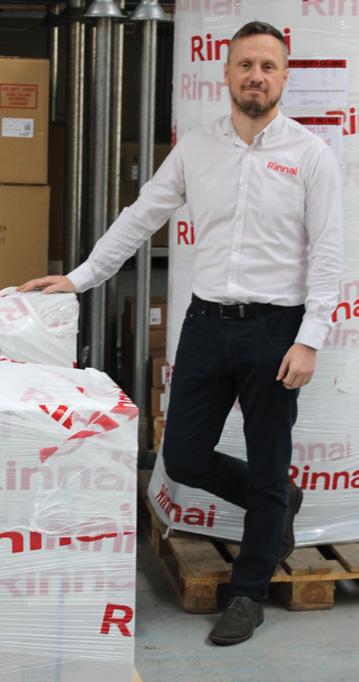
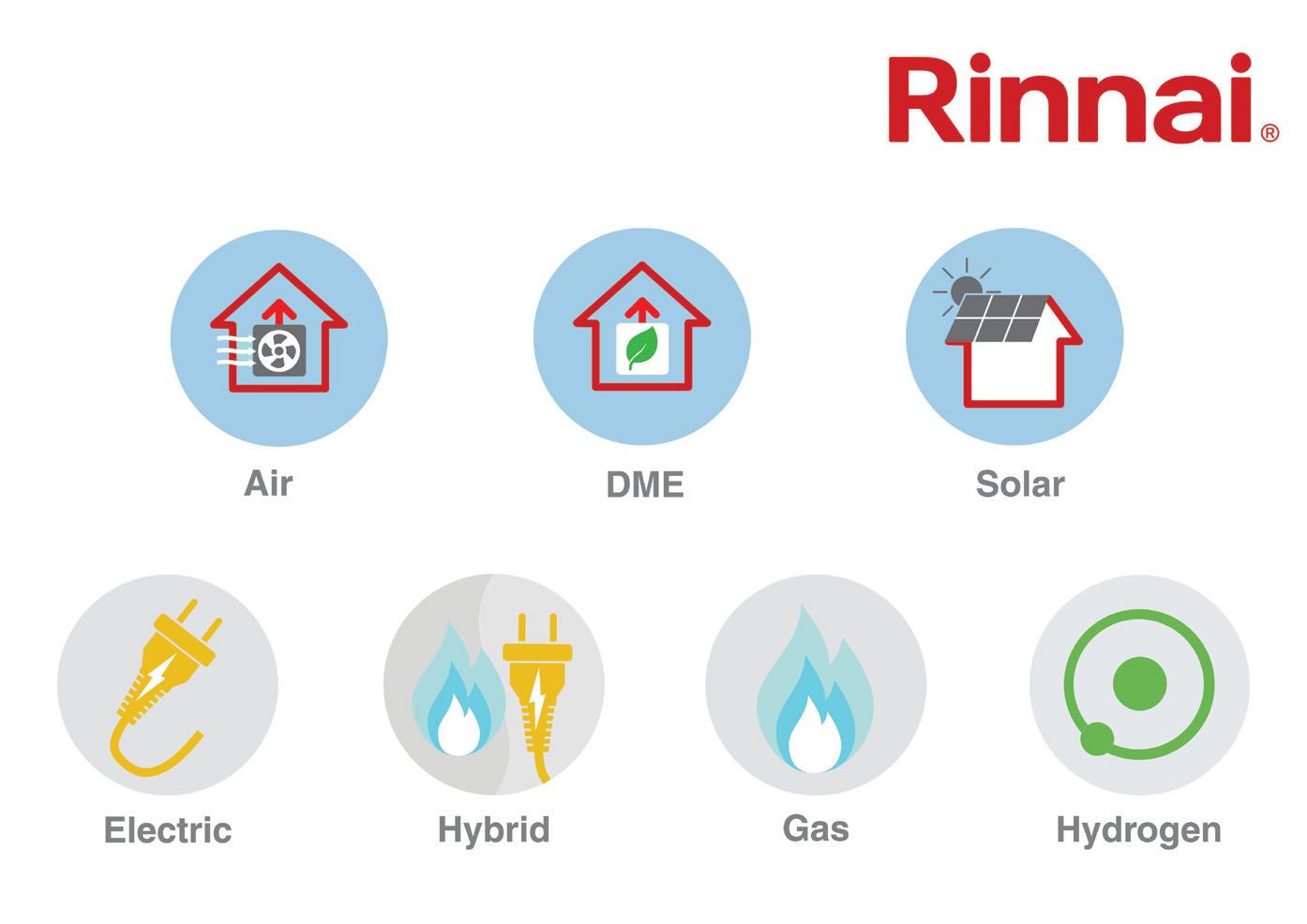
A range of professionals who work in heating and hot water from across northern, east midlands, southern England, and Scotland share what they think on the UK government’s strength of direction relating to future energy dispersal.
The southeast region of England is the most affluent and holds the highest population density in the country. Four installing contractors who specialize in commercial and domestic heating were asked on their thoughts about central policy and governmental direction.
Please note that these are personal views from a selection of installers around the UK.

An installer from Orpington, Kent said: “I’m only currently fitting gas equipment
now. In terms of the future, I think hydrogen will be used over electric boilers. Electric boilers are expensive and need an electrician when fitted. They’re inconvenient and costly.”
A gas engineer located in Sevenoaks, Kent shared his observations: “I like the idea of hydrogen going forward. The only thing that worries me is extra costs that installers must incur through regulations and yearly skill renewal classes. I’m not a huge fan of heat pumps, they can be temperamental. I recently had to take out heat pumps from a whole block of flats. Once temperatures dropped below zero outside, they stopped working.”
A solar engineer based in Biggin Hill, Kent recently switched from installing gas equipment to fitting solar panels shared his thoughts: “I didn’t want to be left behind because they won’t be fitting gas in new builds from 2025. All in all, I’d say solar offers proven technology, is best for the environment and can also be a good investment. I have heard of hydrogen but don’t think it is proven or profitable
enough for the government to use.”
A gas engineer from Croydon, Surrey offered similar opinions: “I think the industry has already started to go solar. If you don’t mind the sight of them on your roof, solar panels can be a good investment. Now I’m fitting more gas equipment than anything else. Hydrogen can be used but extra registration costs worry me.”
A gas engineer from Birmingham is aware of a change to UK energy dispersal – he says: “I still fit gas boilers but have also completed a solar course. I’m still not one hundred per cent sure where the industry will go in the future. It makes sense to think that the government will move towards solar as they profit from it. I’ve heard of hydrogen, but I don’t think big business, or the government will want to use it. It’s cheaper to run and better for the environment but less profit for the big cats. I can’t see hydrogen being used for those reasons.”
A plumber from Nottinghamshire is not happy with the current quality of governmental advice, he added: “the government need to clearly outline the future after natural gas heating, so we know where to focus our attention. It worries me, do I go solar, electric or hydrogen? I’m not being told anything useful, and I’m worried for the future.”
A gas engineer based in Sheffield, Yorkshire believes future UK power will
32 HEATING ENERGY MANAGER MAGAZINE • OCTOBER 2023
not be gas based: “the future is heating pumps and solar. I’ve worked with both and can recommend either of them to my customers. I cannot see hydrogen being used – no way. Existing pipework can’t withstand hydrogen. All pipework will have to be replaced with plastic to cope with hydrogen. That’ll be too costly. Hydrogen can be used for industrial purposes but not for domestic heating.” When also asked on any future fears for job security: “none, I already work in other areas other than gas.”
Another located in Sheffield, Yorkshire feels the future should be focused on green gasses: “looking at the options available to heating I’d have to pick hydrogen – although there are no domestic boilers available, apparently, they are on their way. Electric is too expensive, and I don’t trust solar. I’m currently advising my customers to update their appliances over the coming years to accept hydrogen.”
A gas engineer residing in Glasgow, Scotland, agrees with hydrogen: “we must go hydrogen because it’s compatible with existing infrastructure and the cost won’t be too different to switch your gas system over. It’s best for the environment and all other options have flaws. I’m not concerned for my future.”
Another gas engineer who works in Glasgow, Scotland, is more sceptical on the overall direction of the UK government: “I know the goal is no more gas equipment by 2025, but that’s only new builds – and what are new builds after 2025 getting? Hydrogen could be an easy switch over but there isn’t even any hydrogen equipment or large-scale hydrogen available and we’re two years off. I don’t think the powers have made up their minds. I’ll be okay, I’ll adapt to whatever they come up with.”
It is evident that heating professionals believe they are provided with unclear information of future UK energy dispersal and could benefit from agreed centralized instructions. Decarbonisation of all industrial, domestic, and commercial UK practises is a huge task – however, insight passed down to installers from the UK government could help to accelerate UK decarbonisation aims.
Rinnai understands the current pressures faced by installers, system designers and customers alike. Rinnai aims to provide all customers and professionals with information that creates a better understanding regarding all UK energy matters. Enhanced levels of knowledge encourage improved decision-making skills when purchasing a heating and hot water system.
Visit www.rinnai-uk.co.uk
COMMITTING TO IEQ WHEN OPERATING GASFIRED WATER HEATING

Indoor air quality (IAQ) has become an increasingly important issue within public sector buildings. The World Health Organisation (WHO) guidance on air quality has advised member states to consider air pollution to be as big a threat to human health and well-being as climate change and adjusted almost all its previous maximum target levels for airborne pollutants downwards. It linked long-term exposure to even relatively low concentrations of ambient and indoor air pollution to lung cancer, heart disease, and strokes.
In the wake of the Covid-19 pandemic new UK standards (BS40102-1) were deemed necessary, providing recommendations for measuring, monitoring, and reporting indoor environmental quality (IEQ) in all types of non-domestic buildings. It includes an evaluation and rating system for air quality, lighting, thermal comfort, and acoustics, to help identify retrofit and renovation work required to improve the health and well-being of occupants.
To meet the new standard organisations will need to tackle conditions that have a direct impact on human health including humidity, and excessive levels of CO2, CO, NO2, volatile organic compounds (VOC), airborne particulates and mould.
Adveco has for many years operated a system of checks to ensure the comfort and safety of buildings, from initial system commissioning, to ensure correct and safe installation of appliances, to annual warranty servicing. Commissioning an application upon installation is especially critical if gasfired appliances are an element of the hot water system. One of the most common reasons for a system to fail commissioning is the incorrect installation of the flue, often venting too low or too close to a building’s windows. The commissioning process identifies such errors helping to ensure control and safe removal of CO2 and NO x emissions from proximity to building users.
To improve combustion efficiency, the latest generation of condensing gas water heaters and boilers operate so that the water vapour in the exhaust condenses on the heat exchanger and not in the flue or outside the building. With a high-efficiency pre-mix Fecralloy burner, such as employed in the Adveco MD & AD / ADplus product ranges, ideal combustion efficiency can be achieved up to 107% (net)/98% (gross) reducing energy costs and producing ultra-low emissions. The low CO (19ppm) and especially ultra-
low NO x (27mg/kWh) emissions, from a hot water system built around a high-efficiency condensing water heater or boiler (Class 6 appliance) easily satisfy the requirements of the current Energy-related Products (ErP) directive.
It is also worth mentioning that regular servicing is important for identifying or preventing cases of damaging corrosion (in soft water areas) and limescale build-up (in harder water areas) which can lead to leaks in any hot water system. If unchecked, the resultant damp can encourage the growth of mould which is a type of fungus which produces airborne spores and is recognised as a potentially dangerous contributor to poor IAQ and health risks. Adveco’s range of stainless steel cylinders and smart application of electric boilers can help address the regional geologic threats to a system.
In the drive to achieve net zero public sector organisations looking to make steps towards a more environmentally friendly built environment may initially reject the gas-fired option, but the reality is modern systems remain advantageous both economically and environmentally, plus they provide a bridge towards potential future hydrogen-based alternatives. While new builds will embrace all-electric flueless systems which effectively negate NOx and reduce on-premises CO2 generation, pre-existing commercial sites need to be increasingly vigilant, especially when ageing gas-fired systems remain in use. If your building’s hot water or heating system predates 2018 then there are advantages to be gained from switching to the latest generation of gas-fired water heaters and boilers, if your system is closer to 15 or 20 years old then you really should be giving serious thought to upgrading appliances or transitioning to alternate technologies.
Setting IEQ performance benchmarks will make it easier for facilities managers to target problem areas, but British Standards will require further tightening if they are to keep abreast of the WHO’s more stringent guidelines. If you operate buildings with ageing gas-fired hot water systems and have concerns about IAQ or wish to reduce carbon emissions as part of a sustainability strategy, speak to Adveco about Live Metering, system assessment and replacement options. Whether looking for high-efficiency, ultra-low emission gas appliances or a move to electric boilers, heat pumps or solar thermal we can help with the design, supply, and ongoing service for more efficient, comfortable, and safe working environments. https://adveco.co/
33 ENERGY MANAGER MAGAZINE • OCTOBER 2023 HEATING
15 Accredited Training Courses in Renewable Energy and Energy Efficiency:

Designed to give you the knowledge you need to excel in the renewables industry

Learn about the advantages and uses of different renewable energy technologies with the Master in Renewable Energy Award.
The Master in Renewable Energy Award provides 280+ CPD hours consisting of video lessons, course slides and additional course materials. You will have up to 18 months to complete a minimum of 12 courses at your own pace, but this can be completed as quickly as you would like within this period.
You will have the opportunity to sit an exam for each course to achieve the internationally recognised Galileo Master Certificate. Past achievers include students, professionals and members of large organisations such as Audi, Ministry of Defence, Coca Cola, NATO, Scottish Power and many more.
To register on an accredited pathway, or for further information about the Master in Renewable Energy Award, contact the REI by emailing: training@renewableinstitute.org or by calling us on +44 (0)131 446 9479
Alternatively, please enrol here: www.renewableinstitute.org/ master-in-renewable-energyaward/
34 TRAINING ENERGY MANAGER MAGAZINE • OCTOBER 2023
THE ESOS AUDIT APPROACH HAS LIMITATIONS, HERE’S WHAT NEEDS TO CHANGE
Originally developed as an EU directive, ESOS (Energy Savings Opportunity Scheme) is a mandatory energy assessment scheme for organisations in the UK that meet the qualification criteria. Organisations that qualify must carry out an ESOS assessment over a four-year cycle and submit this to the Environment Agency by a specified deadline. Although there is currently no requirement to implement the recommended actions, non-compliance with the audit process can lead to fines.
The scheme however has been designed as a one-size-fits-all approach, which means it has limitations for most industrial businesses. The mandate for compliance covers turnover and number of staff within such diverse industries as serving coffee and processing natural gas. Consequently, energy reduction schemes would look entirely different for each company.
ESOS is a great opportunity to raise the profile of energy and sustainability in large businesses, some of which will have already implemented a number of projects within that remit. Industry-wide reporting can give businesses an overview of what is being done elsewhere, and the potential benefits that brings. Since 2014 little has changed in the scheme, however many major industrial businesses have embraced Net Zero targets and, in some cases established whole departments to tackle the various issues associated with it.
The audit process itself is where the limitations of the scheme arise, and though individual auditors may be fully converse in the industry they are working with, they are confined by a standard issue checklist. This cannot hope to replicate the detailed documentation and measures that are covered by a specialist energy assessor. The lack of adaptation has led to some participants branding the measures as unrealistic, poor quality, poorly costed and irrelevant to their particular business. By presenting your own quantifiable solutions alongside the ESOS report to the board, this may help secure funding for action where previously limited resources had been a factor.
Another aspect of ESOS to consider is that should the government introduce mandatory policies to implement the
recommended measures, businesses may find themselves in a very difficult position. This is a real possibility for the next cycle of assessment, which concludes in 2027. This approach may work for some but, for a company with proposed or already established decarbonisation projects, it is a huge inconvenience detracting from the value of the measures already – or shortly to be - implemented.
The volatility of energy costs over recent years and uncertainty in the market adds to the issue of implementing energy saving measures, making them difficult to quantify and to project possible savings. Of particular importance in such broad schemes is the payback time, and although this is never pinpoint accurate, it has become virtually impossible to predict. Still, training more auditors in greater depth to evaluate market trends will be necessary to give them a more grounded approach, and enable them to design more tailored solutions with scope for more accurate predictions. Could a different approach work – one that’s impartial and data-led, that measures more than just energy consumption in different areas of the business? An approach that, as well as measured and reported, is also designed to reach the best possible outcome and could assist in the implementation of those measures, both physically and financially? To illustrate, in a project with an energy-intensive business, On-Site Energy recently identified a potential energy saving of over 53% where the ESOS audit found only 6%.
David Kipling, CEO of On-Site Energy explained: “We often see total
dismissal of the auditor’s recommended measures by participants. Auditors can frustrate businesses by working against their energy saving priorities and making recommendations structured against ongoing business costs.
“The ESOS process as it stands is failing to meet business-specific industry needs. It devalues the detailed thought process that energy specialists can provide by implementing a checkliststyle, one-size-fits-all approach.
“On-Site can help your business by tapping into our reserves of expertise, sourcing data driven solutions and providing project management to assist with monitoring and cutting emissions. In addition, we can offer diverse capex and non-capex solutions which can prove a valuable resource for cash-limited industries in implementing these measures.”
An impartial, data-led approach that addresses electrical and thermal energy requirements will always be more persuasive than subjective opinion. It’s unrealistic to think that the same energy usage and cost optimisations that work for an office building can be applied to a chemical manufacturing plant.
Decarbonisation is a long-term project that businesses are taking seriously, but ESOS is a limited approach that needs to be overhauled to reflect the diverse priorities of different industries. It also needs to account for the more complex solutions that can be offered by specialists such as On-Site Energy who take into account more complex data and emerging technologies.

To learn more about how On-Site Energy can help, visit, https://on-site.energy/

35 ENERGY MANAGER MAGAZINE • OCTOBER 2023 LEGISLATION
Build2Perform 2023 is the With over 100 exhibitors
must-attend event in the building services sector

Build2Perform Live 2023 will feature:

Over 50 hours of approved CPD
150 Speakers across 7 theatres
NEW for 2023
SLL - Light2Perform is a dedicated area within Build2Perform Live, CIBSE’s flagship event bringing together our membership and the broader Building Services community for two days of unmissable content, CPD presentations and the latest products and services.
















www.build2perform.co.uk

Featuring leading lighting manufacturers, contractors, wholesalers and retailers, SLLLight2Perform will also have its own content programme running over the two days.
With its own dedicated theatre, all technical content will be organised by leading lighters, Bob Bohannon, Helen Loomes and Sophie Parry.




Register your interest


















































































































































